

The 3 I’s Methodology: A Dynamic Approach to Problem-Solving
Introduction
The need for efficient and effective problem-solving methodologies has never been more significant in the ever-evolving business landscape. Enter the “3 I’s” method, a streamlined approach to tackling challenges across various domains. This method, based on Identify, Ideate, and Implement principles, offers a unique blend of simplicity, flexibility, and effectiveness.
Understanding the 3 I’s Method
At its core, the 3 I’s Method is a structured yet dynamic approach to problem-solving, segmented into three pivotal stages: Identify, Ideate, and Implement. Each stage is integral, forming a comprehensive process that guides us from the initial understanding of a problem to the final implementation of a solution. In the ‘Identify’ stage, we focus on dissecting the problem, gathering necessary information, defining the scope, and setting a solid foundation for solution development. Transitioning to the ‘Ideate’ stage, creativity takes center stage as we explore a myriad of potential solutions, assessing their viability and refining the most promising ones. Finally, these ideas are implemented and meticulously executed in the’ Implement’ stage to bring about real and impactful change. With its straightforward, step-by-step approach, this method is effective across various contexts and empowers problem solvers to tackle challenges confidently and creatively.
In this stage of the 3 I’s method, we embark on a journey of deep understanding and precise definition of the problem. This critical phase lays the foundation for effective problem-solving. It begins with clearly identifying the issue and addressing the proper challenge. Subsequently, we gather meticulous information, collecting data and insights that shed light on various facets of the problem. This is followed by a thorough analysis, where we dissect the information to unearth the root causes and understand the broader context. An essential part of this phase is defining the scope of the problem and setting clear parameters to focus our efforts effectively. We also pay close attention to the stakeholders involved, understanding their needs and how the problem impacts them. The culmination of this stage is goal setting, where we define what a successful resolution would look like. This systematic and reflective approach in the ‘Identify’ phase is crucial for paving the way towards creative creativity and effective implementation, ensuring that we solve the problem and do so in a truly impactful and sustainable way.
In this stage of the 3 I’s method, the creative heart of problem-solving beats the strongest. In a symphony of brainstorming sessions, teams unleash their collective creativity unhindered by constraints or criticism. It’s a phase that values the power of diverse perspectives, bringing together different backgrounds and disciplines to ignite a more comprehensive and innovative set of ideas. The process then shifts to critically evaluating these ideas, sifting through the imaginative storm to identify those most feasible, impactful, and aligned with the established goals. The most promising ideas are then carefully selected and refined, transforming raw concepts into actionable plans. This stage is not just about generating ideas; it’s about sculpting them into practical, real-world solutions, meticulously preparing for their transition into the subsequent implementation phase. It’s here, in the Ideate stage, where imagination is harnessed and directed, setting the stage for tangible change and innovative solutions to come to life.
In the ‘Implement’ stage of the 3 I’s method, the focus shifts from conceptualization to action, where ideas transform into tangible solutions. This phase is the culmination of the process, where the most promising ideas conceived in the Ideate stage are put into practice. It starts with meticulous planning, delineating the steps necessary to bring the solution to life. This includes allocating resources, setting timelines, and defining key performance indicators. Collaboration and communication are paramount during implementation, ensuring all team members are aligned and swiftly addressing obstacles. Monitoring progress is crucial, as it provides insights into the effectiveness of the solution and any adjustments needed. This stage also involves a feedback loop, where responses from the end-users or stakeholders are gathered and analyzed, leading to continuous refinement of the solution. The rubber meets the road in the implementation stage, combining strategic planning, teamwork, and adaptability to turn innovative ideas into successful, real-world applications.
But what sets the 3 I’s methodology apart is its inherent adaptability and straightforward nature, making it an excellent tool for businesses and education, personal development, community projects, healthcare, technology, and environmental management.
Advantages of the 3 I’s Method
The 3 I’s Method, renowned for its streamlined and practical approach to problem-solving, boasts a wide array of benefits that cater to a diverse range of applications and challenges. This versatility sets it apart, making it a preferred choice for many professionals and organizations. In the forthcoming sections, we detail these benefits, exploring how each aspect contributes to the method’s overall efficacy. From its adaptability across different scenarios to its inherent simplicity that makes it accessible to all, the 3 I’s Method’s advantages are varied and profound. We will examine its ability to foster consistency in problem-solving, encourage creativity, facilitate efficient decision-making, enhance collaboration, and promote a cycle of continuous improvement. Each benefit underscores the method’s effectiveness and illustrates its potential to transform how we approach and resolve challenges.
Flexibility and Adaptability
The 3 I’s Method adapts to various contexts and scales, from small projects to considerable organizational challenges. It can be customized to fit different industries and cultural norms, making it versatile for diverse problem-solving scenarios. This adaptability ensures that solutions remain relevant and practical even as conditions and priorities shift.
Simplicity and Accessibility
Following the theme of Flexibility and Adaptability, another critical advantage of the 3 I’s Method is its Simplicity and Accessibility. This method stands out for its user-friendly approach, designed to be easily understood and implemented by people with different levels of skills and expertise. Its straightforward, clear-cut framework demystifies the problem-solving process, allowing teams to engage with it quickly and without extensive training. This accessibility not only streamlines the problem-solving process but also fosters inclusive participation. Team members from various backgrounds can contribute equally, ensuring a collaborative and comprehensive approach to tackling challenges.
Consistency and Uniformity
Building on the method’s simplicity and accessibility, the 3 I’s Method also brings consistency and uniformity to problem-solving. This consistency is achieved through its standardized framework, which can be uniformly applied across different projects and teams. Organizations can use a consistent approach to ensure that their problem-solving processes are more structured and predictable. This uniformity helps create a common language and understanding of problem-solving within teams, facilitating more transparent communication and more efficient collaboration. It also aids in benchmarking and comparing different projects, as the same methodology is applied throughout.
Encouragement of Creativity
A standout feature of the 3 I’s Method is its inherent encouragement of creativity, particularly in the Ideate stage. This method acknowledges and actively fosters creative thinking as a vital problem-solving component. Providing a structured space for brainstorming and idea generation opens the door for innovative and out-of-the-box solutions. This emphasis on creativity ensures that potential solutions are not limited by conventional thinking but are instead enriched by diverse and imaginative perspectives. The method’s flexible framework allows for exploring novel approaches, encouraging teams to think creatively and explore various possibilities before narrowing down to the most effective solutions.
Efficient Decision-Making
The 3 I’s Method significantly enhances decision-making efficiency. Clearly defining each stage of the problem-solving process enables teams to make informed and timely decisions. During the Identify phase, a thorough understanding of the problem sets a solid foundation for decision-making. The Ideate phase’s creative exploration then offers a variety of potential solutions, providing multiple perspectives for consideration. Finally, in the implementation phase, the method ensures that decisions are executed effectively, with a clear plan and actionable steps. This structured approach reduces indecision and streamlines the decision-making process, making it faster and more effective.
Enhanced Collaboration
The 3 I’s Method also plays a pivotal role in enhancing collaboration among team members. Structuring the problem-solving process into distinct stages encourages participation from all team members at each step. In the Identify phase, collective input is crucial for fully understanding the problem. The Ideate phase thrives on diverse perspectives, promoting a culture of shared creativity and open communication. During the Implementation phase, teamwork is essential to execute the chosen solution successfully. This method fosters a collaborative environment where ideas are freely shared and refined, leading to more inclusive and well-rounded solutions.
Cyclic Improvement
A distinctive advantage of the 3 I’s Method is its facilitation of cyclic improvement. This method is designed not as a linear process but as a cycle that can be repeated, allowing for continuous refinement and enhancement of solutions. After the Implement phase, the outcomes and feedback are analyzed, leading back to the Identify phase for further problem understanding and refinement. This iterative process ensures that solutions are not static but are continually evolving in response to new insights and changing conditions. It encourages a mindset of ongoing improvement, where learning and adapting are integral parts of the problem-solving journey. This cyclical nature makes the 3 I’s Method particularly effective for dealing with complex, evolving challenges that require adaptive and progressive solutions.
Application in the Business Community
In the business world, the 3 I’s method is particularly advantageous. It aligns well with the dynamic needs of modern businesses, from startups to established corporations. Whether developing a new product, improving a service, or streamlining operations, this method provides a clear and practical roadmap for tackling business challenges.
Comparison with Other Methodologies
While the 3 I’s method shares similarities with methodologies like Design Thinking, Lean Startup, Six Sigma, and Agile, it stands out in its simplicity and high-level focus. Unlike the more intricate steps of Design Thinking or the rigorous data analysis of Six Sigma, the 3 I’s method offers a more accessible entry point, especially beneficial for smaller teams or projects needing a quick turnaround. It provides the flexibility of Agile without the complexity of its iterative cycles, making it ideal for rapid implementation and adaptability.
Wrapping it all up
The 3 I’s method is more than just a problem-solving framework; it’s a mindset that encourages clarity, creativity, and practical action. Its universal applicability and numerous advantages make it an invaluable tool for tackling challenges effectively, especially in business. Whether you’re a seasoned professional or a budding entrepreneur, the 3 I’s method is a versatile approach that can help turn challenges into opportunities for growth and innovation.
Stories of Success with the 3 I’s Method
The startup’s journey: fintech innovations.
In the heart of Silicon Valley, a small tech startup, “FinTech Innovations,” was brainstorming its next big project. The team identified a prevalent problem among young adults: managing personal finances. They dreamt up features like automated tracking and AI-driven financial advice during their ideation sessions. With a clear vision, they developed “Budget Buddy,” a user-friendly budgeting app. The app was launched in beta to a group of young adults, and the team iteratively improved it based on user feedback. Budget Buddy soon became a financial companion to thousands, revolutionizing how young adults interacted with their finances.
QuickMart’s Transformation
In a bustling city, “QuickMart” stores were everywhere, but long checkout lines were a common complaint. The management team identified improving customer service as their primary goal. Through brainstorming, they came up with various solutions, including self-service kiosks. Implementing these kiosks, QuickMart witnessed a transformation. Checkout times reduced, customer satisfaction soared, and the once-tedious grocery shopping became swift and enjoyable. QuickMart has enhanced not only operational efficiency but also customer satisfaction.
VirtualConnect’s Community Revival
“VirtualConnect,” an online community platform, was experiencing a decline in user engagement. The team set out to revitalize the platform’s vibrancy, identifying the need for more interactive and rewarding user experiences. Their creativity led to two significant initiatives: monthly virtual meetups and a user reward system. Implementing these ideas, VirtualConnect underwent a complete transformation. The platform became a buzzing hub of activity, with lively discussions and renewed user participation, proving itself as a thriving community space once again.
The power and adaptability of the 3 I’s method are evident in these stories. From aiding a tech startup in developing a groundbreaking app to transforming customer service in retail and revitalizing an online community, this method provides a practical, innovative, and efficient problem-solving framework. Its universal applicability across different sectors makes it an invaluable tool for those looking to navigate challenges and capitalize on opportunities with creativity and strategic thinking.
Related Articles

Finding Grant Opportunities: A Comprehensive Guide for Small Business Owners (Part 4)
In Part 3 of our comprehensive guide on grants for small business owners, we discussed how to determine your eligibility for various grant programs. Now…
How to Find Your Next Grant: A Comprehensive Guide for Small Business Owners (Part 3)
In Part 2 of our comprehensive guide on grants for small business owners, we explored various funding opportunities, including federal, state, local, private corporate, and…

Understanding Different Types of Grants: A Comprehensive Guide for Small Business Owners (Part 2)
Exploring Federal, State, Local, Private, and Corporate, as well as Industry-Specific Grants In Part 1 of our comprehensive guide on grants for small business owners,…

A Beginner’s Guide to Web3: The Future of the Internet 🌐
Introduction The internet has come a long way since its inception, evolving from static web pages to interactive experiences that are now an integral part…
My top 10 Best Obsidian Plugins
Obsidian alone is a wonderful and powerful tool, but it also boasts an incredible system that allows for creating obsidian plugins with varying functionality and…
There was a problem reporting this post.
Block Member?
Please confirm you want to block this member.
You will no longer be able to:
- See blocked member's posts
- Mention this member in posts
- Invite this member to groups
- Message this member
- Add this member as a connection
Please note: This action will also remove this member from your connections and send a report to the site admin. Please allow a few minutes for this process to complete.

Can we ask you a few questions?
Do you want to learn how businesses are getting the most out of their tools.
- Spring 2024
- Spring 2023
- Spring 2022
- Spring 2021
- Spring 2020
- Summer 2019
- Spring 2019
- Summer 2018
- Spring 2018
- Spring 2017
- Spring 2016
- Staff and Contact
- Julia Robinson Math Festival
- Teachers’ Circle
- The Three Stages of the Problem-Solving Cycle
Essentially every problem-solving heuristic in mathematics goes back to George Polya’s How to Solve It ; my approach is no exception. However, this cyclic description might help to keep the process cognitively present.
A few months ago, I produced a video describing this the three stages of the problem-solving cycle: Understand, Strategize, and Implement. That is, we must first understand the problem, then we think of strategies that might help solve the problem, and finally we implement those strategies and see where they lead us. During two decades of observing myself and others in the teaching and learning process, I’ve noticed that the most neglected phase is often the first one—understanding the problem.
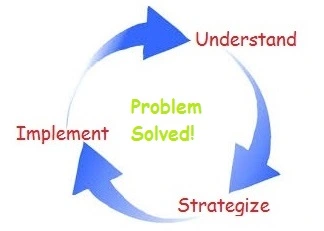
The Three Stages Explained
- What am I looking for?
- What is the unknown?
- Do I understand every word and concept in the problem?
- Am I familiar with the units in which measurements are given?
- Is there information that seems missing?
- Is there information that seems superfluous?
- Is the source of information bona fide? (Think about those instances when a friend gives you a puzzle to solve and you suspect there’s something wrong with the way the puzzle is posed.)
- Logical reasoning
- Pattern recognition
- Working backwards
- Adopting a different point of view
- Considering extreme cases
- Solving a simpler analogous problem
- Organizing data
- Making a visual representation
- Accounting for all possibilities
- Intelligent guessing and testing
I have produced videos explaining each one of these strategies individually using problems we have solved at the Chapel Hill Math Circle.
- Implementing : We now implement our strategy or set of strategies. As we progress, we check our reasoning and computations (if any). Many novice problem-solvers make the mistake of “doing something” before understanding (or at least thinking they understand) the problem. For instance, if you ask them “What are you looking for?”, they might not be able to answer. Certainly, it is possible to have an incorrect understanding of the problem, but that is different from not even realizing that we have to understand the problem before we attempt to solve it!
As we implement our strategies, we might not be able to solve the problem, but we might refine our understanding of the problem. As we refine our understanding of the problem, we can refine our strategy. As we refine our strategy and implement a new approach, we get closer to solving the problem, and so on. Of course, even after several iterations of this cycle spanning across hours, days, or even years, one may still not be able to solve a particular problem. That’s part of the enchanting beauty of mathematics.
I invite you to observe your own thinking—and that of your students—as you move along the problem-solving cycle!
[1] Problem-Solving Strategies in Mathematics , Posamentier and Krulik, 2015.
About the author: You may contact Hector Rosario at [email protected].
Share this:
1 response to the three stages of the problem-solving cycle.
Pingback: When (Not) to Give a Hint | Chapel Hill Math Circle
Leave a comment Cancel reply
- Search for:
Recent Posts
- When (Not) to Give a Hint
- Making “Maths” Make Sense
- Problem-Solving Pedagogy
Recent Comments
- September 2016
- Uncategorized
- Entries feed
- Comments feed
- WordPress.com

- Already have a WordPress.com account? Log in now.
- Subscribe Subscribed
- Copy shortlink
- Report this content
- View post in Reader
- Manage subscriptions
- Collapse this bar
- Privacy and Terms
- BMM Member Login

Episode 2: Three Phase Lesson Format to create a Student Centered Mathematics classroom
by Christina Tondevold | | Changing Instruction , Designing Lessons , Podcast | 4 comments
Welcome fellow Recovering Traditionalists to Episode 2 where we will explore the 3-Phase Lesson Format that is essential to having a student-centered math classroom.
In Episode 1 I shared about Cognitively Guided Instruction. A big part of CGI is teaching math through story problems. Well as I started making that shift away from my textbook and to learning math through problem solving I found the book Teaching Student Centered Mathematics and it was a HUGE help. It quickly became my Math Bible. This is another book that I will likely do multiple episodes about but today is all about the 3-phase lesson format.
The Three-Phase Lesson Format is on pages 24-26 of the edition I have. I know there is a newer edition. Here is the insight from the book:
“A 3-phase lesson format ( Before, During, After ) provides a structure for teaching mathematics through problem solving. Before refers to the time before the children start work on the problem. During refers to the time during which the children work on the problem, and After refers to the discussion that takes place after children work on the problem.” p. 24
The next few pages go into detail about the phases but I’m going to highlight a big take-a-way that I had about each phase.
In the BEFORE phase it is very important to anticipate children’s strategies & their misconceptions. I honestly had never done that before. Even as I made my transition away from the textbook I was just picking problems and giving them to the students without even solving the problem myself sometimes!!! But in order to have a productive DURING and AFTER phase you have to take time exploring the problem yourself and anticipating the way that your students will explore the problem.
The DURING phase is when the kiddos are working on the problem. Now this is hard to admit but during that time I was usually off doing something else. Maybe preparing for the next thing we were doing. Instead the DURING phase should be a time that while the students are exploring the problem, you are exploring their thinking. This is prime time to be looking over shoulders to see what strategies they have and asking questions like “Why do you think that’s right?” “Can you tell me why you did _______?” and so on. These questions and you learning how they solved the problem leads into the AFTER phase.
The AFTER phase is honestly one of the most important. This is where you come together and share solutions and strategies. However, the one thing I didn’t do correctly was the sharing of strategies. I would have kids share but I never helped them make connections between strategies and that is an essential piece to the AFTER phase.
As I started moving away from just doing the next thing in my textbook, this 3-phase lesson format really helped me design my lessons. If you want to learn more about the 3-phase lesson and get some great ideas on activities to do in those lessons then I highly recommend you go get this book .
Subscribe and Review in iTunes
Hey, are you subscribed to the Build Math Minds Podcast, yet? If you’re not, make sure to do that today because I don’t want you to miss any episodes! Click here to subscribe to the podcast in iTunes .
While you’re there, don’t forget to leave a review on iTunes too. I would love to know your thoughts and how we can make sure that we give you content that you will really enjoy.
To leave a review, head over to iTunes and click on “Ratings and Reviews” and “Write a Review.” I can’t wait to hear your thoughts about the podcast.
Other Ways to Listen To This Episode

I agree. I love to ask “why” type questions and truly be interested in the answer without having an answer in mind that I’m expecting. It’s great to anticipate answers but sometimes I get comfortable and assume answers before I let kids fully flesh out their ideas.
Teaching Student Centered Mathematics has been my bible for instruction.
Submit a Comment Cancel reply
Your email address will not be published. Required fields are marked *
Welcome! Enjoy the Build Math Mind Podcast Episodes!
Select a Category
- Changing Instruction
- Designing Lessons
- Inspiration from Educators
- Instructional Theory
- Teaching Through Story Problems
- Uncategorized
- Understanding Math Concepts
- Business Essentials
- Leadership & Management
- Credential of Leadership, Impact, and Management in Business (CLIMB)
- Entrepreneurship & Innovation
- Digital Transformation
- Finance & Accounting
- Business in Society
- For Organizations
- Support Portal
- Media Coverage
- Founding Donors
- Leadership Team

- Harvard Business School →
- HBS Online →
- Business Insights →
Business Insights
Harvard Business School Online's Business Insights Blog provides the career insights you need to achieve your goals and gain confidence in your business skills.
- Career Development
- Communication
- Decision-Making
- Earning Your MBA
- Negotiation
- News & Events
- Productivity
- Staff Spotlight
- Student Profiles
- Work-Life Balance
- AI Essentials for Business
- Alternative Investments
- Business Analytics
- Business Strategy
- Business and Climate Change
- Creating Brand Value
- Design Thinking and Innovation
- Digital Marketing Strategy
- Disruptive Strategy
- Economics for Managers
- Entrepreneurship Essentials
- Financial Accounting
- Global Business
- Launching Tech Ventures
- Leadership Principles
- Leadership, Ethics, and Corporate Accountability
- Leading Change and Organizational Renewal
- Leading with Finance
- Management Essentials
- Negotiation Mastery
- Organizational Leadership
- Power and Influence for Positive Impact
- Strategy Execution
- Sustainable Business Strategy
- Sustainable Investing
- Winning with Digital Platforms
What Is Creative Problem-Solving & Why Is It Important?

- 01 Feb 2022
One of the biggest hindrances to innovation is complacency—it can be more comfortable to do what you know than venture into the unknown. Business leaders can overcome this barrier by mobilizing creative team members and providing space to innovate.
There are several tools you can use to encourage creativity in the workplace. Creative problem-solving is one of them, which facilitates the development of innovative solutions to difficult problems.
Here’s an overview of creative problem-solving and why it’s important in business.
Access your free e-book today.
What Is Creative Problem-Solving?
Research is necessary when solving a problem. But there are situations where a problem’s specific cause is difficult to pinpoint. This can occur when there’s not enough time to narrow down the problem’s source or there are differing opinions about its root cause.
In such cases, you can use creative problem-solving , which allows you to explore potential solutions regardless of whether a problem has been defined.
Creative problem-solving is less structured than other innovation processes and encourages exploring open-ended solutions. It also focuses on developing new perspectives and fostering creativity in the workplace . Its benefits include:
- Finding creative solutions to complex problems : User research can insufficiently illustrate a situation’s complexity. While other innovation processes rely on this information, creative problem-solving can yield solutions without it.
- Adapting to change : Business is constantly changing, and business leaders need to adapt. Creative problem-solving helps overcome unforeseen challenges and find solutions to unconventional problems.
- Fueling innovation and growth : In addition to solutions, creative problem-solving can spark innovative ideas that drive company growth. These ideas can lead to new product lines, services, or a modified operations structure that improves efficiency.

Creative problem-solving is traditionally based on the following key principles :
1. Balance Divergent and Convergent Thinking
Creative problem-solving uses two primary tools to find solutions: divergence and convergence. Divergence generates ideas in response to a problem, while convergence narrows them down to a shortlist. It balances these two practices and turns ideas into concrete solutions.
2. Reframe Problems as Questions
By framing problems as questions, you shift from focusing on obstacles to solutions. This provides the freedom to brainstorm potential ideas.
3. Defer Judgment of Ideas
When brainstorming, it can be natural to reject or accept ideas right away. Yet, immediate judgments interfere with the idea generation process. Even ideas that seem implausible can turn into outstanding innovations upon further exploration and development.
4. Focus on "Yes, And" Instead of "No, But"
Using negative words like "no" discourages creative thinking. Instead, use positive language to build and maintain an environment that fosters the development of creative and innovative ideas.
Creative Problem-Solving and Design Thinking
Whereas creative problem-solving facilitates developing innovative ideas through a less structured workflow, design thinking takes a far more organized approach.
Design thinking is a human-centered, solutions-based process that fosters the ideation and development of solutions. In the online course Design Thinking and Innovation , Harvard Business School Dean Srikant Datar leverages a four-phase framework to explain design thinking.
The four stages are:

- Clarify: The clarification stage allows you to empathize with the user and identify problems. Observations and insights are informed by thorough research. Findings are then reframed as problem statements or questions.
- Ideate: Ideation is the process of coming up with innovative ideas. The divergence of ideas involved with creative problem-solving is a major focus.
- Develop: In the development stage, ideas evolve into experiments and tests. Ideas converge and are explored through prototyping and open critique.
- Implement: Implementation involves continuing to test and experiment to refine the solution and encourage its adoption.
Creative problem-solving primarily operates in the ideate phase of design thinking but can be applied to others. This is because design thinking is an iterative process that moves between the stages as ideas are generated and pursued. This is normal and encouraged, as innovation requires exploring multiple ideas.
Creative Problem-Solving Tools
While there are many useful tools in the creative problem-solving process, here are three you should know:
Creating a Problem Story
One way to innovate is by creating a story about a problem to understand how it affects users and what solutions best fit their needs. Here are the steps you need to take to use this tool properly.
1. Identify a UDP
Create a problem story to identify the undesired phenomena (UDP). For example, consider a company that produces printers that overheat. In this case, the UDP is "our printers overheat."
2. Move Forward in Time
To move forward in time, ask: “Why is this a problem?” For example, minor damage could be one result of the machines overheating. In more extreme cases, printers may catch fire. Don't be afraid to create multiple problem stories if you think of more than one UDP.
3. Move Backward in Time
To move backward in time, ask: “What caused this UDP?” If you can't identify the root problem, think about what typically causes the UDP to occur. For the overheating printers, overuse could be a cause.
Following the three-step framework above helps illustrate a clear problem story:
- The printer is overused.
- The printer overheats.
- The printer breaks down.
You can extend the problem story in either direction if you think of additional cause-and-effect relationships.
4. Break the Chains
By this point, you’ll have multiple UDP storylines. Take two that are similar and focus on breaking the chains connecting them. This can be accomplished through inversion or neutralization.
- Inversion: Inversion changes the relationship between two UDPs so the cause is the same but the effect is the opposite. For example, if the UDP is "the more X happens, the more likely Y is to happen," inversion changes the equation to "the more X happens, the less likely Y is to happen." Using the printer example, inversion would consider: "What if the more a printer is used, the less likely it’s going to overheat?" Innovation requires an open mind. Just because a solution initially seems unlikely doesn't mean it can't be pursued further or spark additional ideas.
- Neutralization: Neutralization completely eliminates the cause-and-effect relationship between X and Y. This changes the above equation to "the more or less X happens has no effect on Y." In the case of the printers, neutralization would rephrase the relationship to "the more or less a printer is used has no effect on whether it overheats."
Even if creating a problem story doesn't provide a solution, it can offer useful context to users’ problems and additional ideas to be explored. Given that divergence is one of the fundamental practices of creative problem-solving, it’s a good idea to incorporate it into each tool you use.
Brainstorming
Brainstorming is a tool that can be highly effective when guided by the iterative qualities of the design thinking process. It involves openly discussing and debating ideas and topics in a group setting. This facilitates idea generation and exploration as different team members consider the same concept from multiple perspectives.
Hosting brainstorming sessions can result in problems, such as groupthink or social loafing. To combat this, leverage a three-step brainstorming method involving divergence and convergence :
- Have each group member come up with as many ideas as possible and write them down to ensure the brainstorming session is productive.
- Continue the divergence of ideas by collectively sharing and exploring each idea as a group. The goal is to create a setting where new ideas are inspired by open discussion.
- Begin the convergence of ideas by narrowing them down to a few explorable options. There’s no "right number of ideas." Don't be afraid to consider exploring all of them, as long as you have the resources to do so.
Alternate Worlds
The alternate worlds tool is an empathetic approach to creative problem-solving. It encourages you to consider how someone in another world would approach your situation.
For example, if you’re concerned that the printers you produce overheat and catch fire, consider how a different industry would approach the problem. How would an automotive expert solve it? How would a firefighter?
Be creative as you consider and research alternate worlds. The purpose is not to nail down a solution right away but to continue the ideation process through diverging and exploring ideas.

Continue Developing Your Skills
Whether you’re an entrepreneur, marketer, or business leader, learning the ropes of design thinking can be an effective way to build your skills and foster creativity and innovation in any setting.
If you're ready to develop your design thinking and creative problem-solving skills, explore Design Thinking and Innovation , one of our online entrepreneurship and innovation courses. If you aren't sure which course is the right fit, download our free course flowchart to determine which best aligns with your goals.

About the Author

- Consultancy
- Online Courses
- Lean Business Model , Lean Six Sigma , Lean Wiki
DMAIC Model | The 5 Phase DMAIC Process to Problem-Solving
- 5 mins to read
- July 1, 2020
- By Reagan Pannell
Summary: An Introduction to DMAIC
Dmaic – the dmaic model.
The 6 Sigma DMAIC model remains the core roadmap for almost all Lean Six Sigma problem-solving approaches that drive quality improvement projects. It is used to ensure a robust problem-solving process is followed to give the best chance of the best solution being found.
A note about the structure and the approach used in this article.
Our approach to DMAIC follows Quentin Brook’s book “Lean Six Sigma & Minitab” which for anyone wishing to study Lean Six Sigma is a must for the Green Belt Course and the Black Belt Course .
What is the DMAIC Model?
DMAIC is short for: Define, Measure, Analyse, Improve and Control. These are the key phases that each project must go through to find the right solution. This flow is the concept behind DMAIC Analysis of an issue and its the DMAIC cycle all projects must go through.
As you can quickly see from the 5 DMAIC phases they follow a logical sequence as we will go through in more detail below. But they also make sure you do not try to jump to implementing a solution before you have properly, defined and measured what you are going to be an improvement.
We all love to jump to solutions, but the DMAIC problem-solving structure helps us have a more rigorous approach so that we do not short cut the process and perhaps miss the best solution or perhaps implement the wrong solution as well. It can help companies better structure their problem-solving approaches and be more robust in their approach.
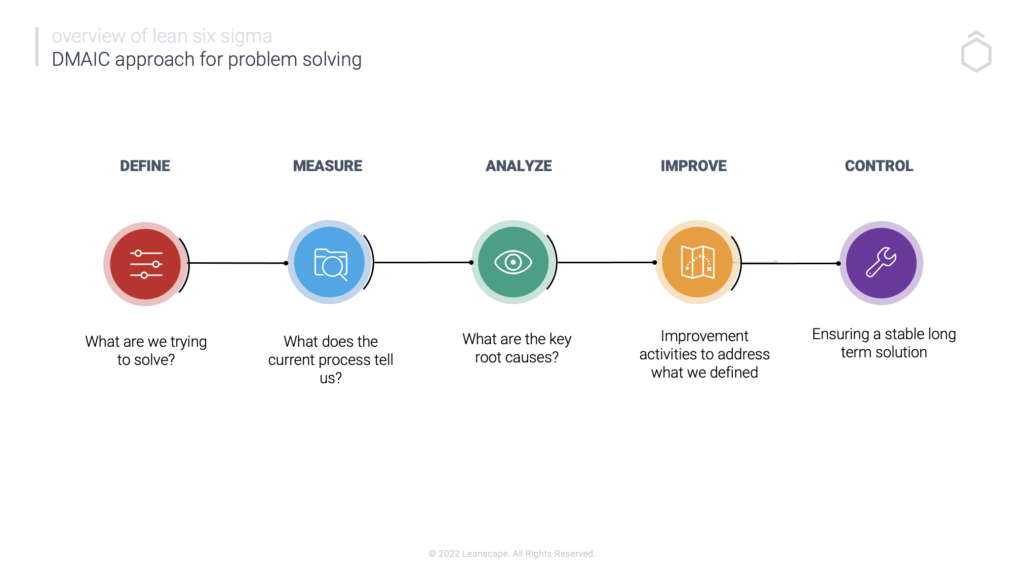
DMAIC – The 5 DMAIC Process Phases
The phases throughout the DMAIC model have and can be broken down in many different ways. One of the best approaches we have found is from Opex Resources which shows how to examine the existing processes, and with a project team, and the sigma improvement process, we can solve complex issues.
DMAIC Define Phase
The purpose of the Define phase is ultimately to describe the problems that need to be solved and for the key business decision-makers to be aligned on the goal of the project. Its about creating and agreeing the project charter .
All too often, teams have identified solutions without actually defining what it is they will actually be trying to do or perhaps not do. This can lead to internal confusion and often solutions which completely miss the business requirements and needs.
- Define the Business Case
- Understand the Consumer
- Define The Process
- Manage the Project
- Gain Project Approval
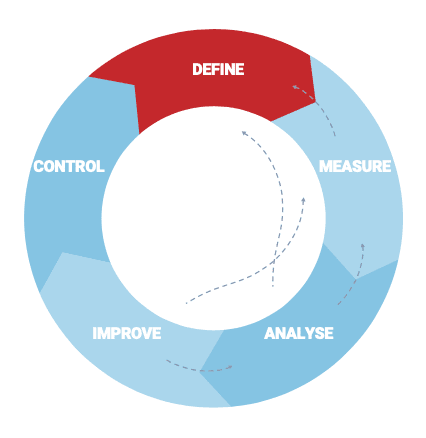
We can’t solve problems by using the same kind of thinking we used when we created them” Albert Einstein Tweet
DMAIC Analyse Phase
The goal of the DMAIC Analyse phase with the lean six sigma improvement process is to identify which process inputs or parameters have the most critical effect on the outputs. In other words, we want to identify the root cause(s) so that we know what critical elements we need to fix.
During this phase, the teams need to explore all potential root causes using both analytical approaches, statistical approaches or even graphical tools such as VSM’s and Process maps to uncover the most important elements which need to be changed/fixed.
The Analyse phase can be broken down into:
- Analyse the Process
- Develop Theories and Ideas
- Analyse the Data
- and finally, Verify Root Causes
DMAIC Improve Phase
The goal of the improvement phase is to identify a wide range of potential solutions before identifying the critical solutions which will give us the maximum return for our investment and directly fix the root cause we identified.
During this phase, the team brainstorm, pilot, test and validate potential improvement ideas before finally implementing the right solutions. With each pilot, the team can validate how well it improves the key measures they identified back in Define and Measure. When the team finally roll out the solution, the results should be seen if the right solution has been found and implemented correctly.
The Improve phase can be broken down into:
- Generate Potential Solutions
- Select the Best Solution
- Assess the Risks
- Pilot and Implement
DMAIC Control Phase
The final part of the DMAIC Model is the Control phase where we need to ensure that the new changes become business as normal and we do not revert to the same way of working as before.
During this phase, we want to ensure that we close the project off by validating the project savings and ensuring the new process is correctly documented. We also need to make sure that new measures and process KPI’s are in place and, finally that we get the business champion to sign off on both the project and the savings. We may need to redesign the workplace following the 5S principles .
The Control phase can be broken down into:
- Implement Ongoing Measurements
- Standardise Solutions
- Quantify the Improvement
- Close The Project
The key closing documents of the Control Phase is a Control Plan that documents all the changes and process steps with key risks, standard work instructions and the Project Close-Out document signed by the business owners to accept the change and the validated benefits.
Our approach to DMAIC follows Quentin Brook’s book “Lean Six Sigma & Minitab” which for anyone wishing to study Lean Six Sigma is a must for the Green Belt Course and the Black Belt Course .
The dmaic model vs. a3 management vs. 8d problem solving.
The DMAIC model is not the only project management roadmap. Two others which are important is the A3 format which originally comes from Toyota and is very Lean focused and the 8D which draws more of the DMAIC structure but with the 1-page idea of the A3.
Everyone has their own preference but each method is interchangeable. The DMAIC Structure lends its self naturally to a multi-slide Powerpoint presentation. Whereas the A3 is a single-page document which is perfect for internal communication and adding into War Rooms and Control Towers.
What’s important is that every problem-solving approach follows the PDCA (Plan, Do, Check and Act) Scientific Problem Solving format. The reset is just a preference or using the right tool in the right circumstances.
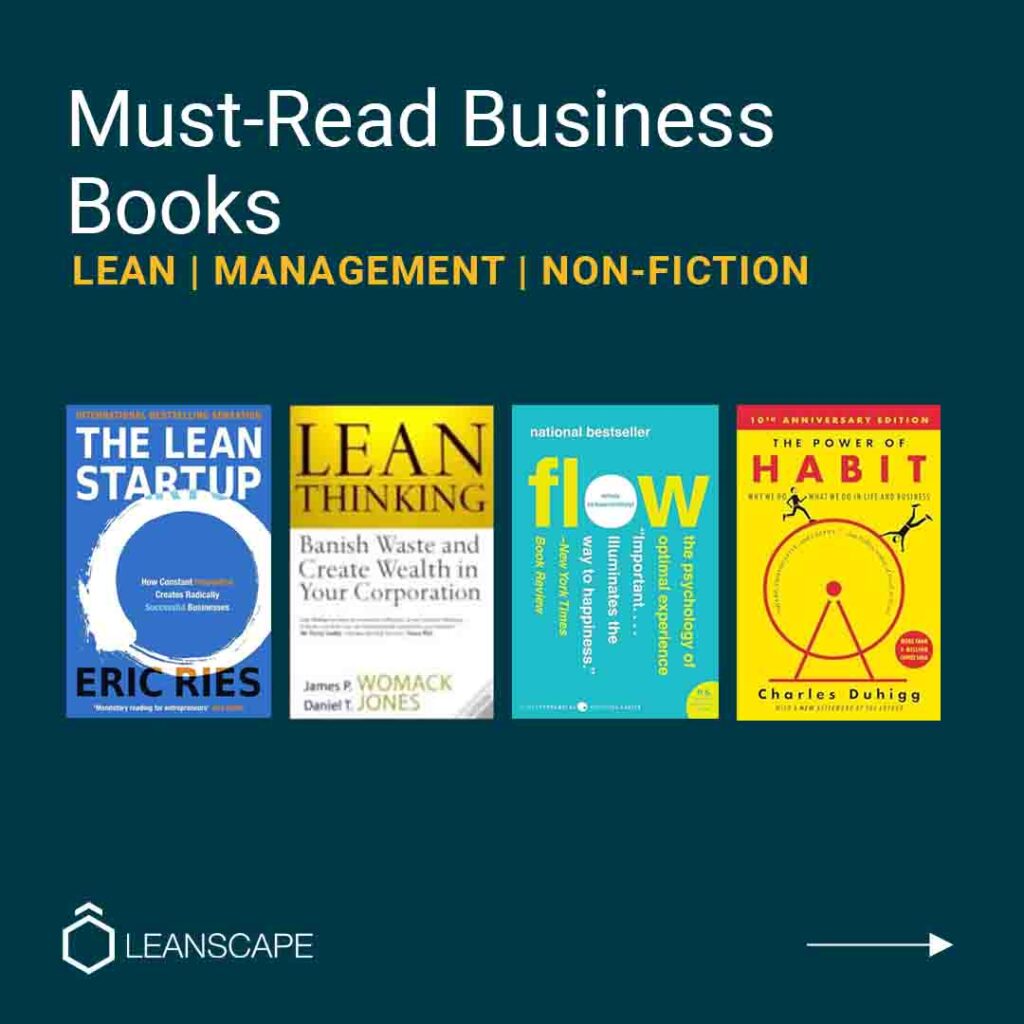
Accelerate your success
Connect with our team.

Similar Articles

Using Lean to Improve Decision-Making Processes

Understanding Standard Work in Lean Six Sigma
View all articles, other articles.

Theory, Action, Reflection and Why Projects Fail

Why Corporate Training Programs Fail | How Problem-Solving Works

Importance of Free Online Courses in Business Management

What is the 1 Proportion Test in Lean Six Sigma?
The only way to make change happen is to take the next step. transform your organisation into a competitive leader., never miss an update.
Get our Weekly recap with the latest news, articles and resources.
Related Articles

Leanscape Announces Leadership Coaching Services

Unlock Business Innovation with the Lean Business Model Canvas

2024 Recommended Reads for Transformative Thinking
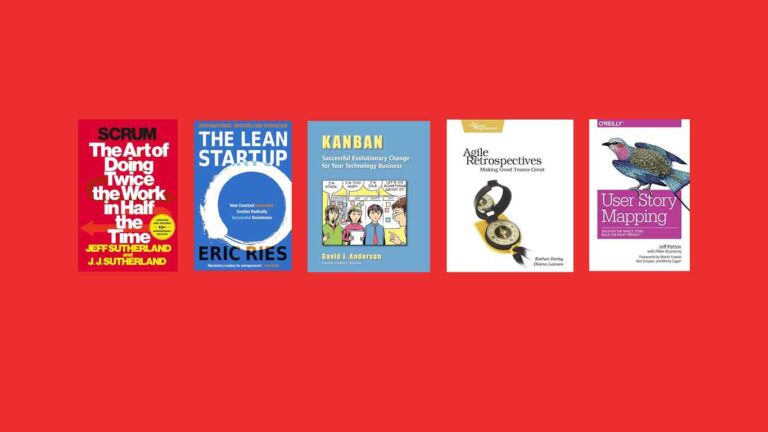
10 Best Books on Agile, Scrum and Design Thinking


The Ultimate Guide to Lean and Manufacturing: Boosting Efficiency and Productivity
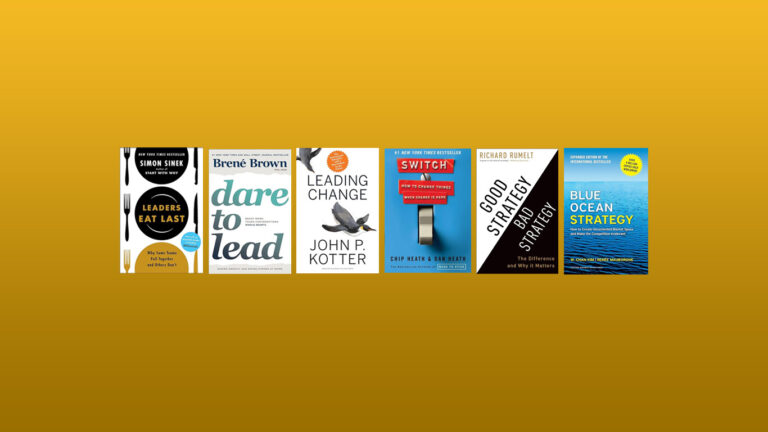
10 Best Management Books for Leaders and Change Makers

Mastering Software Development Agile: A Practical Guide

The Most Popular Tools of Six Sigma
Lean six sigma online courses.
FREE COURSE | YELLOW BELT | GREEN BELT | BLACK BELT | MASTERCLASS | WORKSHOPS
Fundamentals of Lean
Ready to start your journey into the world of Lean with this free course?
FREE COURSE
Lean Thinking
A Lean focused continious improvement certification course
LSS Yellow Belt
Propel your career forward, tackle complex problems and drive change
LSS Green Belt
The ultimate fast-track for future leadership
LSS Black Belt
Become an expert in change management and complex problem-solving.
TAKE OUR QUIZ
Which course is right for you.
Take our short quiz to find out which of our courses is right for you.
Get in touch ✦ Learn how we can help you

Master the 7-Step Problem-Solving Process for Better Decision-Making
Discover the powerful 7-Step Problem-Solving Process to make better decisions and achieve better outcomes. Master the art of problem-solving in this comprehensive guide. Download the Free PowerPoint and PDF Template.
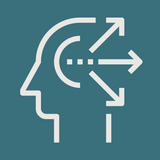
StrategyPunk
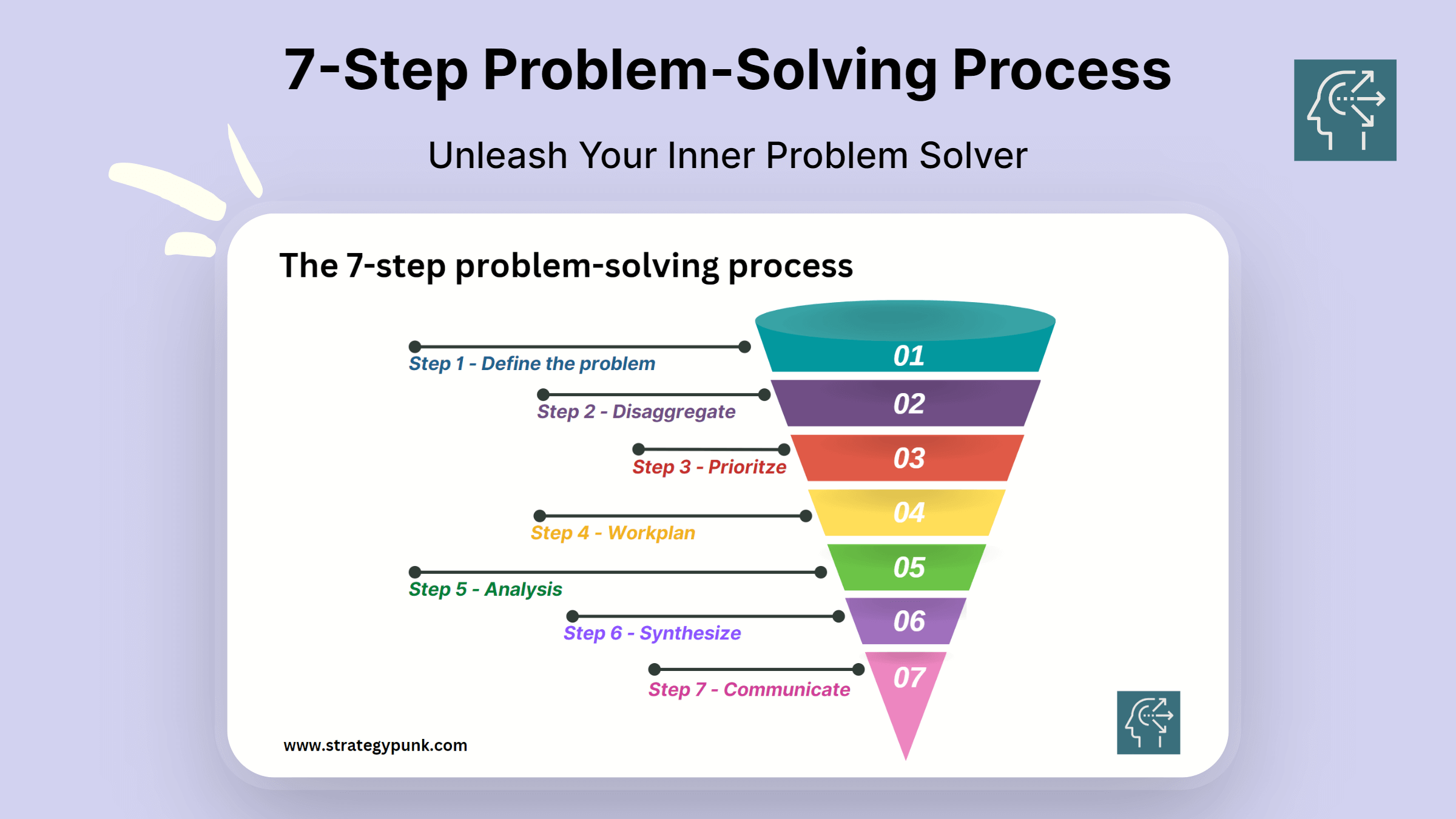
Introduction
Mastering the art of problem-solving is crucial for making better decisions. Whether you're a student, a business owner, or an employee, problem-solving skills can help you tackle complex issues and find practical solutions. The 7-Step Problem-Solving Process is a proven method that can help you approach problems systematically and efficiently.
The 7-Step Problem-Solving Process involves steps that guide you through the problem-solving process. The first step is to define the problem, followed by disaggregating the problem into smaller, more manageable parts. Next, you prioritize the features and create a work plan to address each. Then, you analyze each piece, synthesize the information, and communicate your findings to others.
By following this process, you can avoid jumping to conclusions, overlooking important details, or making hasty decisions. Instead, you can approach problems with a clear and structured mindset, which can help you make better decisions and achieve better outcomes.
In this article, we'll explore each step of the 7-Step Problem-Solving Process in detail so you can start mastering this valuable skill. At the end of the blog post, you can download the process's free PowerPoint and PDF templates .
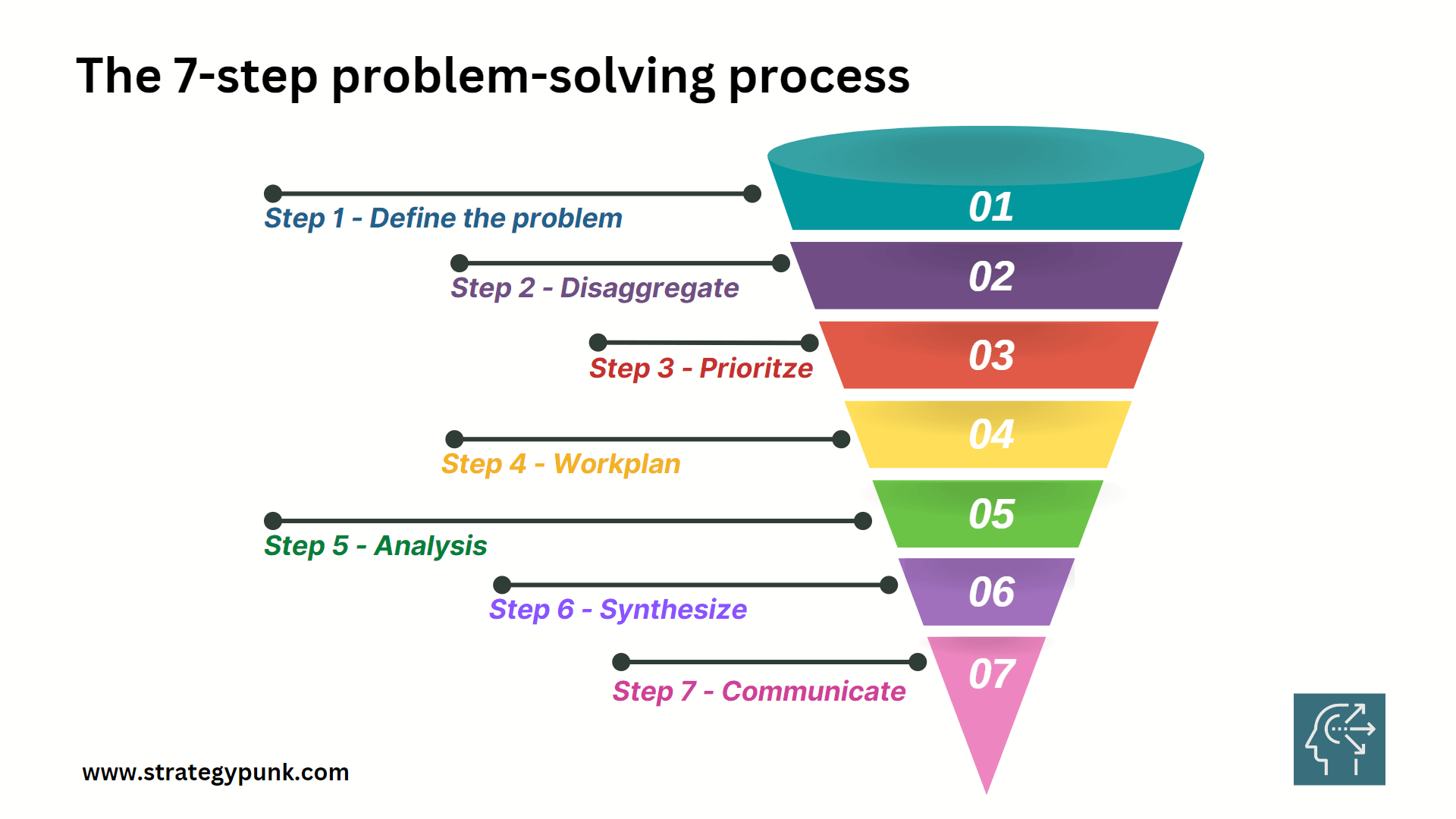
Step 1: Define the Problem
The first step in the problem-solving process is to define the problem. This step is crucial because finding a solution is only accessible if the problem is clearly defined. The problem must be specific, measurable, and achievable.
One way to define the problem is to ask the right questions. Questions like "What is the problem?" and "What are the causes of the problem?" can help. Gathering data and information about the issue to assist in the definition process is also essential.
Another critical aspect of defining the problem is identifying the stakeholders. Who is affected by it? Who has a stake in finding a solution? Identifying the stakeholders can help ensure that the problem is defined in a way that considers the needs and concerns of all those affected.
Once the problem is defined, it is essential to communicate the definition to all stakeholders. This helps to ensure that everyone is on the same page and that there is a shared understanding of the problem.
Step 2: Disaggregate
After defining the problem, the next step in the 7-step problem-solving process is to disaggregate the problem into smaller, more manageable parts. Disaggregation helps break down the problem into smaller pieces that can be analyzed individually. This step is crucial in understanding the root cause of the problem and identifying the most effective solutions.
Disaggregation can be achieved by breaking down the problem into sub-problems, identifying the contributing factors, and analyzing the relationships between these factors. This step helps identify the most critical factors that must be addressed to solve the problem.
A tree or fishbone diagram is one effective way to disaggregate a problem. These diagrams help identify the different factors contributing to the problem and how they are related. Another way is to use a table to list the other factors contributing to the situation and their corresponding impact on the issue.
Disaggregation helps in breaking down complex problems into smaller, more manageable parts. It helps understand the relationships between different factors contributing to the problem and identify the most critical factors that must be addressed. By disaggregating the problem, decision-makers can focus on the most vital areas, leading to more effective solutions.
Step 3: Prioritize
After defining the problem and disaggregating it into smaller parts, the next step in the 7-step problem-solving process is prioritizing the issues that need addressing. Prioritizing helps to focus on the most pressing issues and allocate resources more effectively.
There are several ways to prioritize issues, including:
- Urgency: Prioritize issues based on their urgency. Problems that require immediate attention should be addressed first.
- Impact: Prioritize issues based on their impact on the organization or stakeholders. Problems with a high impact should be given priority.
- Resources: Prioritize issues based on the resources required to address them. Problems that require fewer resources should be dealt with first.
It is important to involve stakeholders in the prioritization process, considering their concerns and needs. This can be done through surveys, focus groups, or other forms of engagement.
Once the issues have been prioritized, developing a plan of action to address them is essential. This involves identifying the resources required, setting timelines, and assigning responsibilities.
Prioritizing issues is a critical step in problem-solving. By focusing on the most pressing problems, organizations can allocate resources more effectively and make better decisions.
Step 4: Workplan
After defining the problem, disaggregating, and prioritizing the issues, the next step in the 7-step problem-solving process is to develop a work plan. This step involves creating a roadmap that outlines the steps needed to solve the problem.
The work plan should include a list of tasks, deadlines, and responsibilities for each team member involved in the problem-solving process. Assigning tasks based on each team member's strengths and expertise ensures the work is completed efficiently and effectively.
Creating a work plan can help keep the team on track and ensure everyone is working towards the same goal. It can also help to identify potential roadblocks or challenges that may arise during the problem-solving process and develop contingency plans to address them.
Several tools and techniques can be used to develop a work plan, including Gantt charts, flowcharts, and mind maps. These tools can help to visualize the steps needed to solve the problem and identify dependencies between tasks.
Developing a work plan is a critical step in the problem-solving process. It provides a clear roadmap for solving the problem and ensures everyone involved is aligned and working towards the same goal.
Step 5: Analysis
Once the problem has been defined and disaggregated, the next step is to analyze the information gathered. This step involves examining the data, identifying patterns, and determining the root cause of the problem.
Several methods can be used during the analysis phase, including:
- Root cause analysis
- Pareto analysis
- SWOT analysis
Root cause analysis is a popular method used to identify the underlying cause of a problem. This method involves asking a series of "why" questions to get to the root cause of the issue.
Pareto analysis is another method that can be used during the analysis phase. This method involves identifying the 20% of causes responsible for 80% of the problems. By focusing on these critical causes, organizations can make significant improvements.
Finally, SWOT analysis is a valuable tool for analyzing the internal and external factors that may impact the problem. This method involves identifying the strengths, weaknesses, opportunities, and threats related to the issue.
Overall, the analysis phase is critical for identifying the root cause of the problem and developing practical solutions. By using a combination of methods, organizations can gain a deeper understanding of the issue and make informed decisions.
Step 6: Synthesize
Once the analysis phase is complete, it is time to synthesize the information gathered to arrive at a solution. During this step, the focus is on identifying the most viable solution that addresses the problem. This involves examining and combining the analysis results for a clear and concise conclusion.
One way to synthesize the information is to use a decision matrix. This involves creating a table that lists the potential solutions and the essential criteria for making a decision. Each answer is then rated against each standard, and the scores are tallied to arrive at a final decision.
Another approach to synthesizing the information is to use a mind map. This involves creating a visual representation of the problem and the potential solutions. The mind map can identify the relationships between the different pieces of information and help prioritize the solutions.
During the synthesis phase, it is vital to remain open-minded and consider all potential solutions. Involving all stakeholders in the decision-making process is essential to ensure everyone's perspectives are considered.
Step 7: Communicate
After synthesizing the information, the next step is communicating the findings to the relevant stakeholders. This is a crucial step because it helps to ensure that everyone is on the same page and that the decision-making process is transparent.
One effective way to communicate the findings is through a well-organized report. The report should include the problem statement, the analysis, the synthesis, and the recommended solution. It should be clear, concise, and easy to understand.
In addition to the report, a presentation explaining the findings is essential. The presentation should be tailored to the audience and highlight the report's key points. Visual aids such as tables, graphs, and charts can make the presentation more engaging.
During the presentation, it is essential to be open to feedback and questions from the audience. This helps ensure everyone agrees with the recommended solution and addresses concerns or objections.
Effective communication is vital to ensuring the decision-making process is successful. Stakeholders can make informed decisions and work towards a common goal by communicating the findings clearly and concisely.
The 7-step problem-solving process is a powerful tool for helping individuals and organizations make better decisions. By following these steps, individuals can identify the root cause of a problem, prioritize potential solutions, and develop a clear plan of action. This process can be applied to various scenarios, from personal challenges to complex business problems.
Through disaggregation, individuals can break down complex problems into smaller, more manageable parts. By prioritizing potential solutions, individuals can focus their efforts on the most impactful actions. The work step allows individuals to develop a clear action plan, while the analysis step provides a framework for evaluating possible solutions.
The synthesis step combines all the information gathered to develop a comprehensive solution. Finally, the communication step allows individuals to share their answers with others and gather feedback.
By mastering the 7-step problem-solving process, individuals can become more effective decision-makers and problem-solvers. This process can help individuals and organizations save time and resources while improving outcomes. With practice, individuals can develop the skills to apply this process to a wide range of scenarios and make better decisions in all areas of life.
7-Step Problem-Solving Process PPT Template
Free powerpoint and pdf template, executive summary: the 7-step problem-solving process.
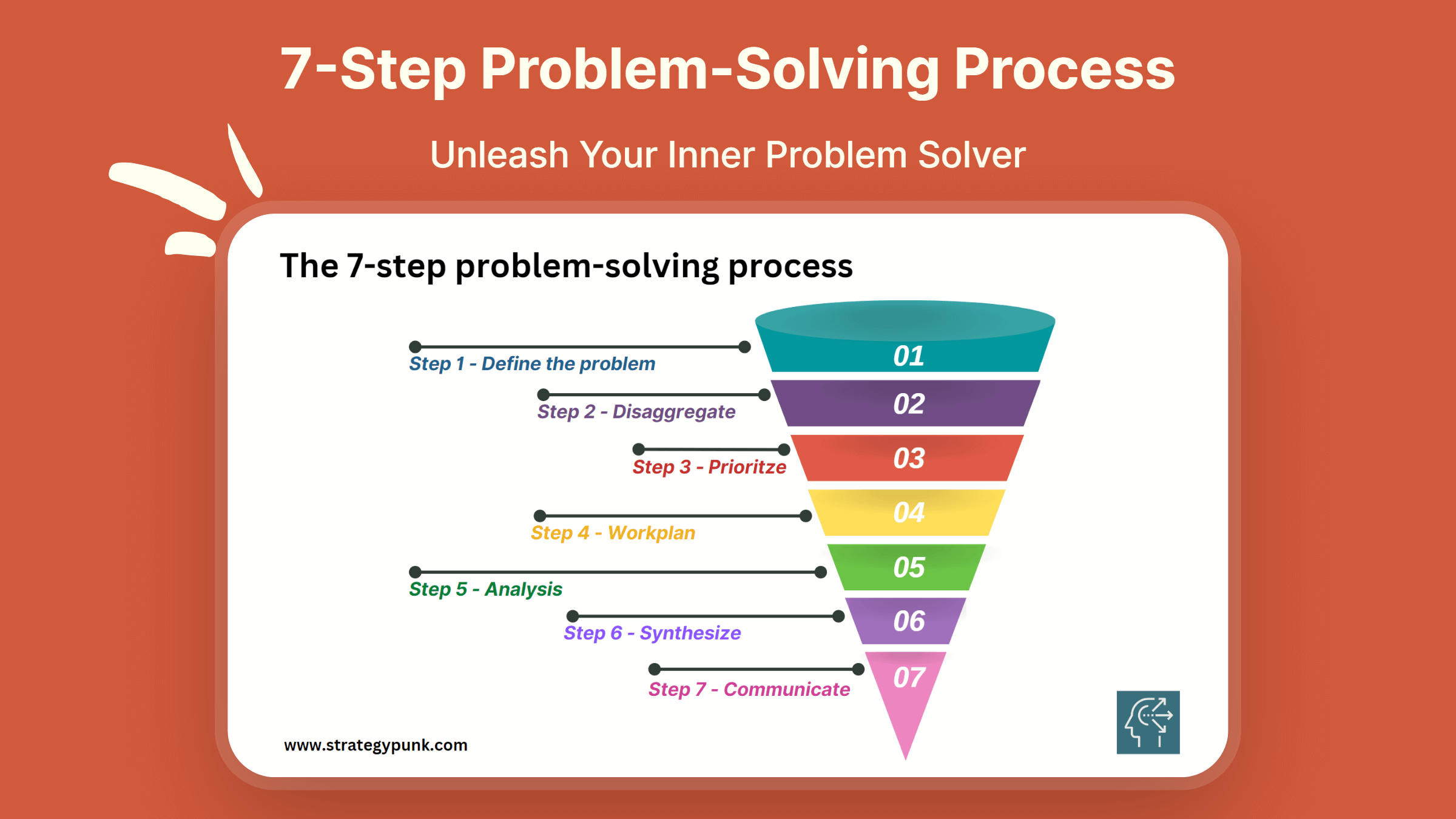
The 7-Step Problem-Solving Process is a robust and systematic method to help individuals and organizations make better decisions by tackling complex issues and finding practical solutions. This process comprises defining the problem, disaggregating it into smaller parts, prioritizing the issues, creating a work plan, analyzing the data, synthesizing the information, and communicating the findings.
By following these steps, individuals can identify the root cause of a problem, break it down into manageable components, and prioritize the most impactful actions. The work plan, analysis, and synthesis steps provide a framework for developing comprehensive solutions, while the communication step ensures transparency and stakeholder engagement.
Mastering this process can improve decision-making and problem-solving capabilities, save time and resources, and improve outcomes in personal and professional contexts.
Please buy me a coffee.
I'd appreciate your support if my templates have saved you time or helped you start a project. Buy Me a Coffee is a simple way to show your appreciation and help me continue creating high-quality templates that meet your needs.

7-Step Problem-Solving Process PDF Template
7-step problem-solving process powerpoint template.
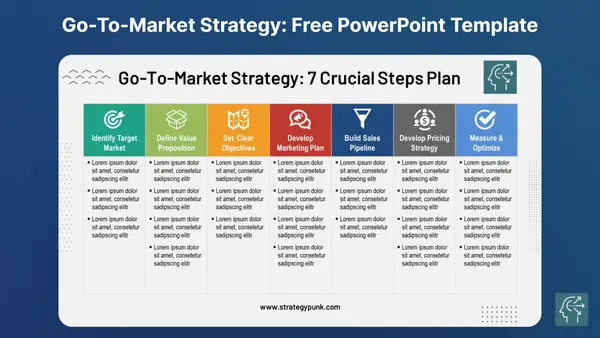
Mastering Your Go-To-Market Strategy: 7 Crucial Steps for Success (Plus Free PPT Template)
Launch your product with confidence. Our step-by-step guide shows you how to build a winning go-to-market strategy, plus grab our free PowerPoint template to get started.

PESTLE Analysis: NVIDIA (PowerPoint Template)
Explore NVIDIA’s PESTLE analysis, detailing how Political, Economic, Social, Technological, Legal, and Environmental factors shape its growth and global strategy.
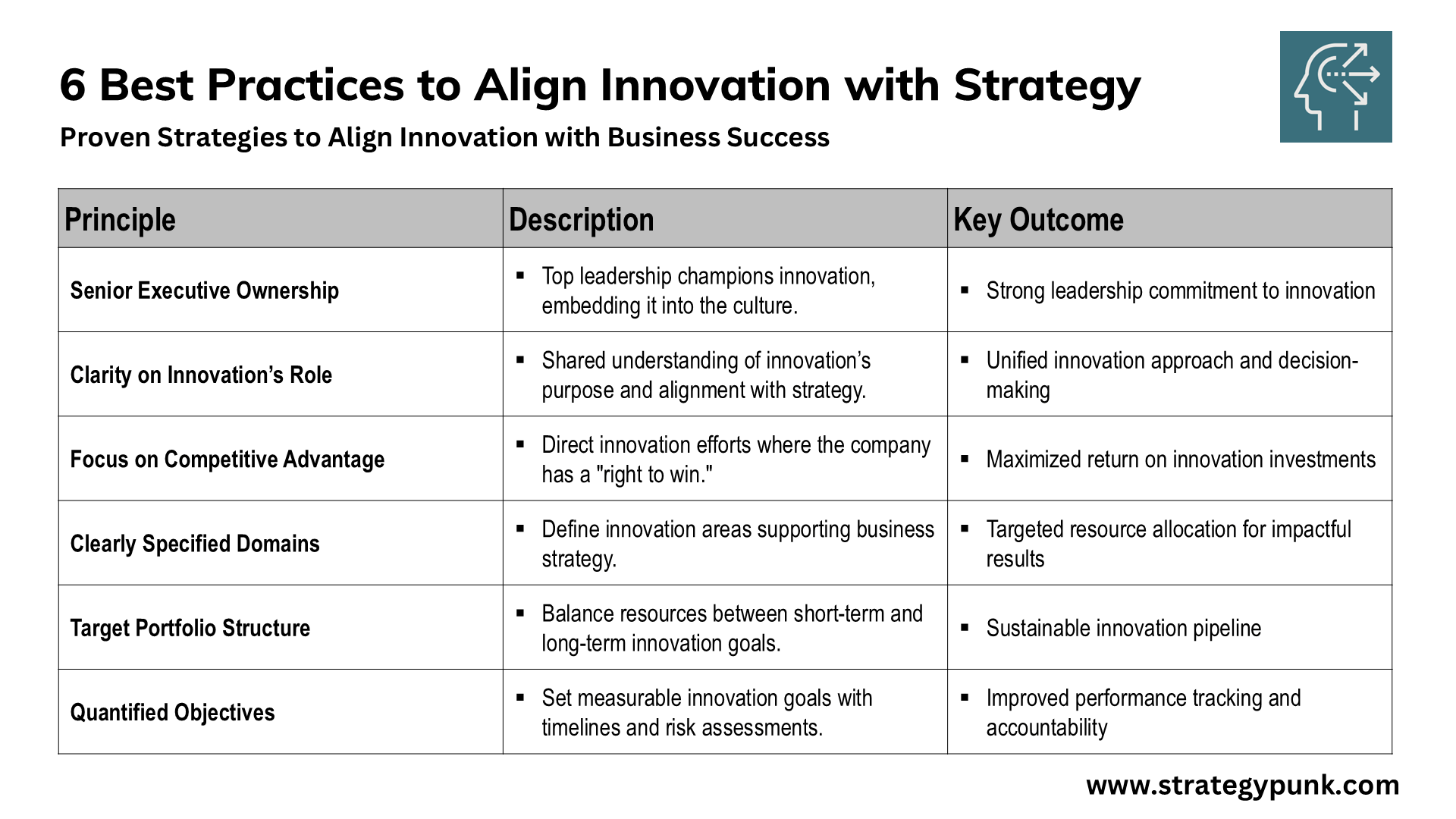
6 Best Practices to Align Innovation with Strategy (by Boston Consulting Group)
Download our free PDF & PPT template on 6 proven strategies to align innovation with business goals. Learn how top companies drive innovation success and customize it for your team!
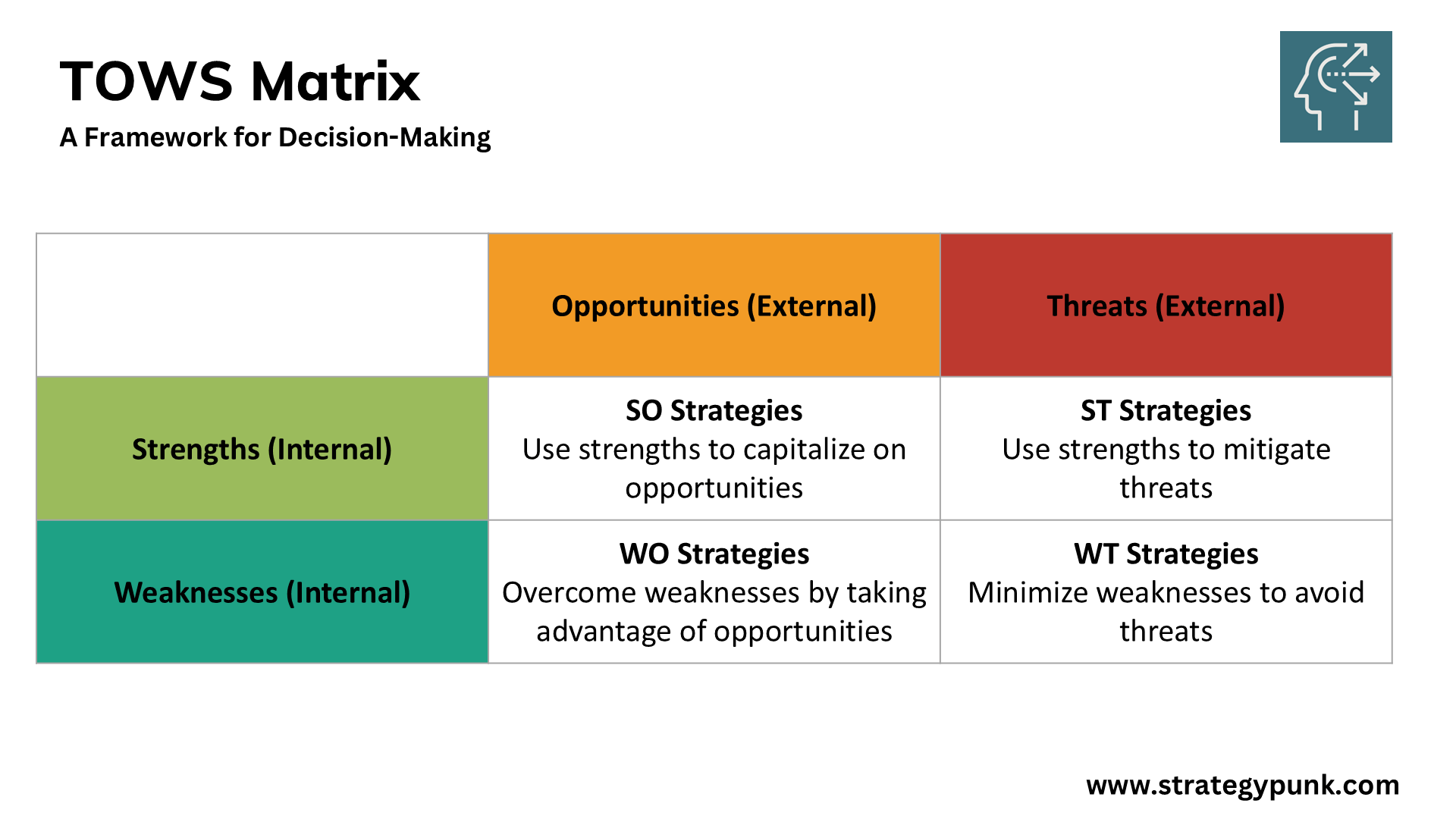
Strategic Planning with the TOWS Matrix - A Framework for Decision-Making (FREE PPT)
Elevate your strategic planning with our FREE TOWS Matrix guide. Discover the powerful framework that sets successful companies apart. Transform your decision-making today! 🎯
- Bipolar Disorder
- Therapy Center
- When To See a Therapist
- Types of Therapy
- Best Online Therapy
- Best Couples Therapy
- Managing Stress
- Sleep and Dreaming
- Understanding Emotions
- Self-Improvement
- Healthy Relationships
- Student Resources
- Personality Types
- Guided Meditations
- Verywell Mind Insights
- 2024 Verywell Mind 25
- Mental Health in the Classroom
- Editorial Process
- Meet Our Review Board
- Crisis Support
Overview of the Problem-Solving Mental Process
Kendra Cherry, MS, is a psychosocial rehabilitation specialist, psychology educator, and author of the "Everything Psychology Book."
:max_bytes(150000):strip_icc():format(webp)/IMG_9791-89504ab694d54b66bbd72cb84ffb860e.jpg)
Rachel Goldman, PhD FTOS, is a licensed psychologist, clinical assistant professor, speaker, wellness expert specializing in eating behaviors, stress management, and health behavior change.
:max_bytes(150000):strip_icc():format(webp)/Rachel-Goldman-1000-a42451caacb6423abecbe6b74e628042.jpg)
- Identify the Problem
- Define the Problem
- Form a Strategy
- Organize Information
- Allocate Resources
- Monitor Progress
- Evaluate the Results
Frequently Asked Questions
Problem-solving is a mental process that involves discovering, analyzing, and solving problems. The ultimate goal of problem-solving is to overcome obstacles and find a solution that best resolves the issue.
The best strategy for solving a problem depends largely on the unique situation. In some cases, people are better off learning everything they can about the issue and then using factual knowledge to come up with a solution. In other instances, creativity and insight are the best options.
It is not necessary to follow problem-solving steps sequentially, It is common to skip steps or even go back through steps multiple times until the desired solution is reached.
In order to correctly solve a problem, it is often important to follow a series of steps. Researchers sometimes refer to this as the problem-solving cycle. While this cycle is portrayed sequentially, people rarely follow a rigid series of steps to find a solution.
The following steps include developing strategies and organizing knowledge.
1. Identifying the Problem
While it may seem like an obvious step, identifying the problem is not always as simple as it sounds. In some cases, people might mistakenly identify the wrong source of a problem, which will make attempts to solve it inefficient or even useless.
Some strategies that you might use to figure out the source of a problem include :
- Asking questions about the problem
- Breaking the problem down into smaller pieces
- Looking at the problem from different perspectives
- Conducting research to figure out what relationships exist between different variables
2. Defining the Problem
After the problem has been identified, it is important to fully define the problem so that it can be solved. You can define a problem by operationally defining each aspect of the problem and setting goals for what aspects of the problem you will address
At this point, you should focus on figuring out which aspects of the problems are facts and which are opinions. State the problem clearly and identify the scope of the solution.
3. Forming a Strategy
After the problem has been identified, it is time to start brainstorming potential solutions. This step usually involves generating as many ideas as possible without judging their quality. Once several possibilities have been generated, they can be evaluated and narrowed down.
The next step is to develop a strategy to solve the problem. The approach used will vary depending upon the situation and the individual's unique preferences. Common problem-solving strategies include heuristics and algorithms.
- Heuristics are mental shortcuts that are often based on solutions that have worked in the past. They can work well if the problem is similar to something you have encountered before and are often the best choice if you need a fast solution.
- Algorithms are step-by-step strategies that are guaranteed to produce a correct result. While this approach is great for accuracy, it can also consume time and resources.
Heuristics are often best used when time is of the essence, while algorithms are a better choice when a decision needs to be as accurate as possible.
4. Organizing Information
Before coming up with a solution, you need to first organize the available information. What do you know about the problem? What do you not know? The more information that is available the better prepared you will be to come up with an accurate solution.
When approaching a problem, it is important to make sure that you have all the data you need. Making a decision without adequate information can lead to biased or inaccurate results.
5. Allocating Resources
Of course, we don't always have unlimited money, time, and other resources to solve a problem. Before you begin to solve a problem, you need to determine how high priority it is.
If it is an important problem, it is probably worth allocating more resources to solving it. If, however, it is a fairly unimportant problem, then you do not want to spend too much of your available resources on coming up with a solution.
At this stage, it is important to consider all of the factors that might affect the problem at hand. This includes looking at the available resources, deadlines that need to be met, and any possible risks involved in each solution. After careful evaluation, a decision can be made about which solution to pursue.
6. Monitoring Progress
After selecting a problem-solving strategy, it is time to put the plan into action and see if it works. This step might involve trying out different solutions to see which one is the most effective.
It is also important to monitor the situation after implementing a solution to ensure that the problem has been solved and that no new problems have arisen as a result of the proposed solution.
Effective problem-solvers tend to monitor their progress as they work towards a solution. If they are not making good progress toward reaching their goal, they will reevaluate their approach or look for new strategies .
7. Evaluating the Results
After a solution has been reached, it is important to evaluate the results to determine if it is the best possible solution to the problem. This evaluation might be immediate, such as checking the results of a math problem to ensure the answer is correct, or it can be delayed, such as evaluating the success of a therapy program after several months of treatment.
Once a problem has been solved, it is important to take some time to reflect on the process that was used and evaluate the results. This will help you to improve your problem-solving skills and become more efficient at solving future problems.
A Word From Verywell
It is important to remember that there are many different problem-solving processes with different steps, and this is just one example. Problem-solving in real-world situations requires a great deal of resourcefulness, flexibility, resilience, and continuous interaction with the environment.
Get Advice From The Verywell Mind Podcast
Hosted by therapist Amy Morin, LCSW, this episode of The Verywell Mind Podcast shares how you can stop dwelling in a negative mindset.
Follow Now : Apple Podcasts / Spotify / Google Podcasts
You can become a better problem solving by:
- Practicing brainstorming and coming up with multiple potential solutions to problems
- Being open-minded and considering all possible options before making a decision
- Breaking down problems into smaller, more manageable pieces
- Asking for help when needed
- Researching different problem-solving techniques and trying out new ones
- Learning from mistakes and using them as opportunities to grow
It's important to communicate openly and honestly with your partner about what's going on. Try to see things from their perspective as well as your own. Work together to find a resolution that works for both of you. Be willing to compromise and accept that there may not be a perfect solution.
Take breaks if things are getting too heated, and come back to the problem when you feel calm and collected. Don't try to fix every problem on your own—consider asking a therapist or counselor for help and insight.
If you've tried everything and there doesn't seem to be a way to fix the problem, you may have to learn to accept it. This can be difficult, but try to focus on the positive aspects of your life and remember that every situation is temporary. Don't dwell on what's going wrong—instead, think about what's going right. Find support by talking to friends or family. Seek professional help if you're having trouble coping.
Davidson JE, Sternberg RJ, editors. The Psychology of Problem Solving . Cambridge University Press; 2003. doi:10.1017/CBO9780511615771
Sarathy V. Real world problem-solving . Front Hum Neurosci . 2018;12:261. Published 2018 Jun 26. doi:10.3389/fnhum.2018.00261
By Kendra Cherry, MSEd Kendra Cherry, MS, is a psychosocial rehabilitation specialist, psychology educator, and author of the "Everything Psychology Book."
- Skip to main content
- Skip to primary sidebar
- Skip to footer
Additional menu

The 5 steps of the solving problem process
August 17, 2023 by MindManager Blog
Whether you run a business, manage a team, or work in an industry where change is the norm, it may feel like something is always going wrong. Thankfully, becoming proficient in the problem solving process can alleviate a great deal of the stress that business issues can create.
Understanding the right way to solve problems not only takes the guesswork out of how to deal with difficult, unexpected, or complex situations, it can lead to more effective long-term solutions.
In this article, we’ll walk you through the 5 steps of problem solving, and help you explore a few examples of problem solving scenarios where you can see the problem solving process in action before putting it to work.
Understanding the problem solving process
When something isn’t working, it’s important to understand what’s at the root of the problem so you can fix it and prevent it from happening again. That’s why resolving difficult or complex issues works best when you apply proven business problem solving tools and techniques – from soft skills, to software.
The problem solving process typically includes:
- Pinpointing what’s broken by gathering data and consulting with team members.
- Figuring out why it’s not working by mapping out and troubleshooting the problem.
- Deciding on the most effective way to fix it by brainstorming and then implementing a solution.
While skills like active listening, collaboration, and leadership play an important role in problem solving, tools like visual mapping software make it easier to define and share problem solving objectives, play out various solutions, and even put the best fit to work.
Before you can take your first step toward solving a problem, you need to have a clear idea of what the issue is and the outcome you want to achieve by resolving it.
For example, if your company currently manufactures 50 widgets a day, but you’ve started processing orders for 75 widgets a day, you could simply say you have a production deficit.
However, the problem solving process will prove far more valuable if you define the start and end point by clarifying that production is running short by 25 widgets a day, and you need to increase daily production by 50%.
Once you know where you’re at and where you need to end up, these five steps will take you from Point A to Point B:
- Figure out what’s causing the problem . You may need to gather knowledge and evaluate input from different documents, departments, and personnel to isolate the factors that are contributing to your problem. Knowledge visualization software like MindManager can help.
- Come up with a few viable solutions . Since hitting on exactly the right solution – right away – can be tough, brainstorming with your team and mapping out various scenarios is the best way to move forward. If your first strategy doesn’t pan out, you’ll have others on tap you can turn to.
- Choose the best option . Decision-making skills, and software that lets you lay out process relationships, priorities, and criteria, are invaluable for selecting the most promising solution. Whether it’s you or someone higher up making that choice, it should include weighing costs, time commitments, and any implementation hurdles.
- Put your chosen solution to work . Before implementing your fix of choice, you should make key personnel aware of changes that might affect their daily workflow, and set up benchmarks that will make it easy to see if your solution is working.
- Evaluate your outcome . Now comes the moment of truth: did the solution you implemented solve your problem? Do your benchmarks show you achieved the outcome you wanted? If so, congratulations! If not, you’ll need to tweak your solution to meet your problem solving goal.
In practice, you might not hit a home-run with every solution you execute. But the beauty of a repeatable process like problem solving is that you can carry out steps 4 and 5 again by drawing from the brainstorm options you documented during step 2.
Examples of problem solving scenarios
The best way to get a sense of how the problem solving process works before you try it for yourself is to work through some simple scenarios.
Here are three examples of how you can apply business problem solving techniques to common workplace challenges.
Scenario #1: Manufacturing
Building on our original manufacturing example, you determine that your company is consistently short producing 25 widgets a day and needs to increase daily production by 50%.
Since you’d like to gather data and input from both your manufacturing and sales order departments, you schedule a brainstorming session to discover the root cause of the shortage.
After examining four key production areas – machines, materials, methods, and management – you determine the cause of the problem: the material used to manufacture your widgets can only be fed into your equipment once the machinery warms up to a specific temperature for the day.
Your team comes up with three possible solutions.
- Leave your machinery running 24 hours so it’s always at temperature.
- Invest in equipment that heats up faster.
- Find an alternate material for your widgets.
After weighing the expense of the first two solutions, and conducting some online research, you decide that switching to a comparable but less expensive material that can be worked at a lower temperature is your best option.
You implement your plan, monitor your widget quality and output over the following week, and declare your solution a success when daily production increases by 100%.
Scenario #2: Service Delivery
Business training is booming and you’ve had to onboard new staff over the past month. Now you learn that several clients have expressed concern about the quality of your recent training sessions.
After speaking with both clients and staff, you discover there are actually two distinct factors contributing to your quality problem:
- The additional conference room you’ve leased to accommodate your expanding training sessions has terrible acoustics
- The AV equipment you’ve purchased to accommodate your expanding workforce is on back-order – and your new hires have been making do without
You could look for a new conference room or re-schedule upcoming training sessions until after your new equipment arrives. But your team collaboratively determines that the best way to mitigate both issues at once is by temporarily renting the high-quality sound and visual system they need.
Using benchmarks that include several weeks of feedback from session attendees, and random session spot-checks you conduct personally, you conclude the solution has worked.
Scenario #3: Marketing
You’ve invested heavily in product marketing, but still can’t meet your sales goals. Specifically, you missed your revenue target by 30% last year and would like to meet that same target this year.
After collecting and examining reams of information from your sales and accounting departments, you sit down with your marketing team to figure out what’s hindering your success in the marketplace.
Determining that your product isn’t competitively priced, you map out two viable solutions.
- Hire a third-party specialist to conduct a detailed market analysis.
- Drop the price of your product to undercut competitors.
Since you’re in a hurry for results, you decide to immediately reduce the price of your product and market it accordingly.
When revenue figures for the following quarter show sales have declined even further – and marketing surveys show potential customers are doubting the quality of your product – you revert back to your original pricing, revisit your problem solving process, and implement the market analysis solution instead.
With the valuable information you gain, you finally arrive at just the right product price for your target market and sales begin to pick up. Although you miss your revenue target again this year, you meet it by the second quarter of the following year.
Kickstart your collaborative brainstorming sessions and try MindManager for free today !
Ready to take the next step?
MindManager helps boost collaboration and productivity among remote and hybrid teams to achieve better results, faster.
Why choose MindManager?
MindManager® helps individuals, teams, and enterprises bring greater clarity and structure to plans, projects, and processes. It provides visual productivity tools and mind mapping software to help take you and your organization to where you want to be.
Explore MindManager
- SUGGESTED TOPICS
- The Magazine
- Newsletters
- Managing Yourself
- Managing Teams
- Work-life Balance
- The Big Idea
- Data & Visuals
- Case Selections
- HBR Learning
- Topic Feeds
- Account Settings
- Email Preferences
Data & Visuals

Partner Center

Continuous Improvement Toolkit
Effective Tools for Business and Life!
A3 Thinking: A Structured Approach to Problem Solving

- 5 MINUTES READ
Also known as A3 Problem Solving.
Variants include 8D and CAPA.
A significant part of a leader’s role involves addressing problems as they arise. Various approaches and tools are available to facilitate problem-solving which is the driving force behind continuous improvement. These methods range from the advanced and more complex methodologies like Six Sigma to the simpler and more straightforward A3 thinking approach.
The power of the A3 approach lies in its systematic and structured approach to problem-solving. Although it appears to be a step-by-step process, A3 is built around the PDCA philosophy. It relies on the principle that it is much better to address the real root-cause rather than trying to find a solution. Hence, it’s important not to jump to the solution when solving a problem as it is likely to be less effective.
A3 thinking provides an effective way to bring together many of the problem-solving tools into one place. For example, techniques such as the 5 Whys and fishbone analysis can be used during the ‘Analysis’ stage to help identifying the root causes. Additionally, visual aids and graphs are highly recommended in the A3 report, as they are more effective than text in communicating ideas and providing concise project updates.
A3 thinking involves the practice of consolidating the problem, analysis, countermeasures, and action plan onto a single sheet of paper, commonly an A3-sized sheet. This brief document serves as a summary of the project at hand and is regarded as a valuable storytelling tool for project communication. Utilizing the A3 approach doesn’t require any specialized software or advanced computer skills. You may however use readily available A3 templates , or rely on basic tools such as paper, pencil and an eraser as you will need to erase and rewrite several times.
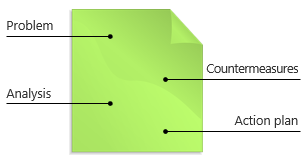
One of the characteristics of the A3 approach is that it does not get into specific details. Detailed documents are usually attached to the A3 report to prevent overwhelming the reader with an excess of information.
The A3 process is typically structured in multiple stages based on the PDCA model. The primary focus is on developing understanding of the current situation and defining the desired outcome before thinking about the solution. While the exact number of stages may vary depending on the preference of the company, what truly matters is adhering to a structured approach to problem-solving.
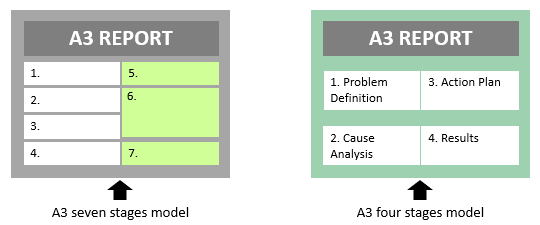
A3 Seven Stages Model
An A3 process is often managed by an individual who should own and maintain the A3 report. This individual takes the lead in steering the process, facilitating team involvement, and preparing the A3 report with team input. One of the most common models for A3 thinking is the seven stages model which is described in the following.
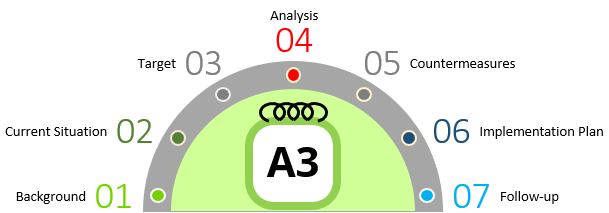
1. Background – The first step is to identify the business reason for choosing this problem or opportunity. In this stage, you need to identify the gap in performance and the extent of the problem.
2. Current situation – The purpose of this stage is to document the current state of the problem. You may need to refer to the process map or go to the Gemba to truly understand the current situation.
3. Target – The purpose of this stage is to define the desired future state. Clearly identify the expected benefits from solving the problem, the scope, and the key metrics that will help measure the success of the project.
4. Analysis – The objective of this stage is to conduct an in-depth analysis of the problem and understand why it’s happening. It might involve tools like the 5 Whys and cause-and-effect analysis, as well as advanced statistical methods.
5. Countermeasures – Countermeasures are the actions to be taken to eliminate root causes or reduce their effects. The team should brainstorm and evaluate possible countermeasures based on the analysis conducted earlier.
6. Implementation Plan – To achieve the target, develop a workable plan to implement the countermeasures. Gantt charts are great ways to manage implementation plans very simply and easily. Once the action plan is finalized, the team should begin working on the activities needed to implement the countermeasures.
7. Follow-up – The final stage involves evaluating the implementation of the plan and the results achieved. Follow-up actions are important to ensure the benefits extend beyond the project’s completion.
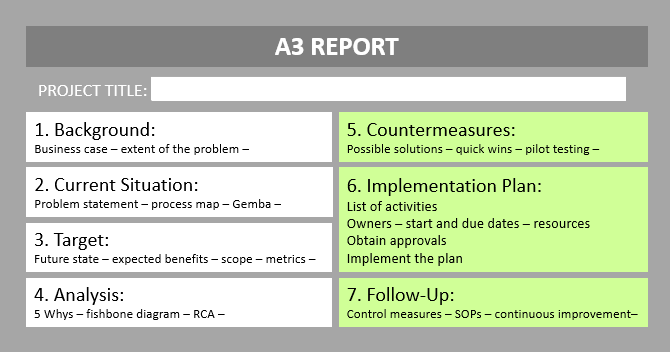
A3 thinking is considered to be the practical form of the PDCA model.
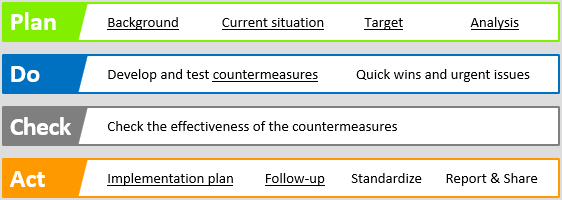
There are many online templates that can be used to manage your problem-solving efforts. One of the simplest and most straightforward ways is to use this A3 problem solving template .
Wrapping Up
A3 thinking represents a logical and structured approach for problem solving and continuous improvement. This approach can be used for most kinds of problems and in any part of the business. Originating from the Toyota Production System (TPS), it has been adopted by many Lean organizations around the world.
A3 thinking not only provides a systematic approach for problem-solving. The development of a continuous improvement culture is at the core of A3 thinking. It has become one of the most popular Lean tools today where people and teams work together to solve problems, share results and learn from each other.
Other Formats

Do you want to use the slides in your training courses?
A3 Thinking Training Material – $18.85
Related Articles
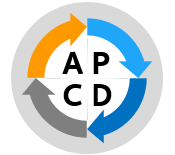
Project Charter

Gantt Chart
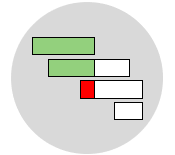
Related Templates
A3 Problem Solving
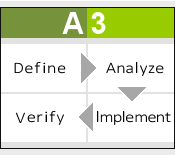
Written by:
CIToolkit Content Team
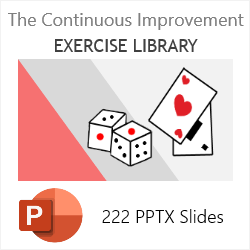
- 281.412.7766
- [email protected]
- GET YOUR CAUSE MAPPING TEMPLATE

- About Cause Mapping®
- What is Root Cause Analysis?
- Cause Mapping® Method
- Cause Mapping® FAQs
- Why ThinkReliability?
- Online Workshops
- Online Short Courses
- On-Demand Training Catalog
- On-Demand Training Subscription
- Company Case Study
- Upcoming Webinars
- Webinar Archives
- Public Workshops
- Private Workshops
- Cause Mapping Certified Facilitator Program
- Our Services
- Facilitation, Consulting, and Coaching
- Root Cause Analysis Program Development
- Work Process Reliability™
- Cause Mapping® Template
- Root Cause Analysis Examples
- Video Library
- Articles and Downloads
- About ThinkReliability
- Client List
- Testimonials

Problem Solving - 3 Basic Steps
Don't complicate it.
Problems can be confusing. Your problem-solving process shouldn’t make them more confusing. With a variety of different tools available, it’s common for people in the same company to use different approaches and different terminology. This makes problem solving problematic. It shouldn’t be.
Some companies use 5Whys , some use fishbone diagrams , and some categorize incidents into generic buckets like " human error " and " procedure not followed ." Some problem-solving methods have six steps, some have eight steps and some have 14 steps. It’s easy to understand how employees get confused.
6-sigma is another widely recognized problem-solving tool. It has five steps with its own acronym, DMAIC: define, measure, analyze, improve and control. The first two steps are for defining and measuring the problem . The third step is the analysis . And the fourth and fifth steps are improve and control, and address solutions .
3 Basic Steps of Problem Solving
As the name suggests, problem solving starts with a problem and ends with solutions. The step in the middle is the analysis. The level of detail within a problem changes based on the magnitude of an issue, but the basic steps of problem solving remain the same regardless of the type of problem:
Step 1. Problem
Step 2. analysis, step 3. solutions.
But these steps are not necessarily what everyone does. Some groups jump directly to solutions after a hasty problem definition. The analysis step is regularly neglected. Individuals and organizations don’t dig into the details that are essential to understand the issue. In the Cause Mapping® method, the point of root cause analysis is to reveal what happened within an incident—to do that digging.
Step 1. Problem
A complete problem definition consists of several different questions:
- What is the problem?
- When did it happen?
- Where did it happen?
- What was the total impact to each of the organization’s overall goals?
These four questions capture what individuals see as a problem, along with the specifics about the setting of the issue (the time and place), and, importantly, the overall consequences to the organization. The traditional approach of writing a problem description as a few sentences doesn’t necessarily capture the information needed for a complete definition. Some organizations see their problem as a single effect, but that doesn’t reflect the nature of an actual issue since different negative outcomes can occur within the same incident. Specific pieces of information are captured within each of the four questions to provide a thorough definition of the problem.
The analysis step provides a clear explanation of an issue by breaking it down into parts. A simple way to organize the details of an incident is to make a timeline . Each piece of the incident in placed in chronological order. A timeline is an effective way to understand what happened and when for an issue.
Ultimately, the objective of problem solving is to turn the negative outcomes defined in step 1 into positive results. To do so, the causes that produced the unwanted outcomes must be identified. These causes provide both the explanation of the issue as well as control points for different solution options. This cause-and-effect approach is the basis of explaining and preventing a problem solving. It’s why cause-and-effect thinking is fundamental for troubleshooting, critical thinking and effective root cause analysis.
Many organizations are under-analyzing their problems because they stop at generic categories like procedure not followed, training less than adequate or management systems . This is a mistake. Learning how to dig a littler further, by asking more Why questions, can reveal significant insight about those chronic problems that people have come to accept as normal operations.
A Cause Map™ diagram provides a way for frontline personnel, technical leads and managers to communicate the details of an issue objectively, accurately and thoroughly. A cause-and-effect analysis can begin as a single, linear path that can be expanded into as much detail as needed to fully understand the issue.
Solutions are specific actions that control specific causes to produce specific outcomes. Both short-term and long-term solutions can be identified from a clear and accurate analysis. It is also important for people to understand that every cause doesn’t need to be solved. Most people believe that 15 causes require 15 solutions. That is not true. Changing just one cause along a causal path breaks that chain of events. Providing solutions on more than one causal path provides additional layers of protection to further reduce the risk of a similar issue occurring in the future.
The Basics of Problem Solving Don't Change
These three steps of problem solving can be applied consistently across an organization from frontline troubleshooters to the executives. First principles should be the foundation of a company’s problem-solving culture. Overlooking these basics erodes critical thinking. Even though the fundamentals of cause-and-effect don’t change, organizations and individuals continue to find special adjectives, algorithms and jargon appealing. Teaching too many tools and using contrived terms such as “true root causal factors” is a symptom of ignoring lean principles. Don’t do that which is unnecessary.
Your problems may be complex, but your problem-solving process should be clear and simple. A scientific approach that objectively explains what happened and why (cause and effect) is sound. It’s the basis for understanding and solving a problem – any problem. It works on the farm, in the power plant, at the manufacturing company and at an airline. It works for the cancer researcher and for the auto mechanic. It also works the same way for safety incidents, production losses and equipment failures. Cause and effect doesn’t change. Just test it.
If you’re interested in seeing one of your problems dissected as a Cause Map diagram, send us an email or call the ThinkReliability office. We’ll arrange a call to step through your issue. You can also learn more about improving the way your organization investigates and prevents problems through one of our upcoming online webinars, short courses or workshops .
Want to learn more? Watch our 28-minute video on problem-solving basics.
Share This Post With A Friend
Similar Posts
Other resources.
- Root Cause Analysis blog
- Patient Safety blog
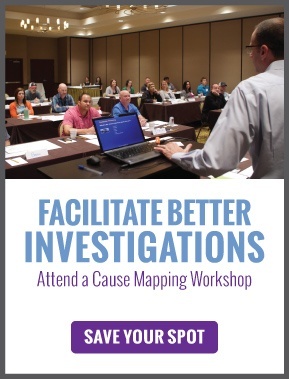
READ BY - - - - - - - - - -

Other Resources - - - - - - - - - -

Sign Up For Our eNewsletter
Problem-Solving Theory: The Task-Centred Model
- Living reference work entry
- First Online: 12 April 2022
- Cite this living reference work entry

- Blanca M. Ramos 5 &
- Randall L. Stetson 6
Part of the book series: Social Work ((SOWO))
635 Accesses
This chapter examines the task-centred model to illustrate the application of problem-solving theory for social work intervention. First, it provides a brief description of the problem-solving model. Its historical development and key principles and concepts are presented. Next, the chapter offers a general overview of the crisis intervention model. The task-centred model and crisis intervention share principles and methods drawn from problem-solving theory. The remainder of the chapter focuses on the task-centred model. It reviews its historical background, viability as a framework for social work generalist practice, as well as its applicability with diverse client populations and across cultural settings. The structured steps that guide task-centred implementation throughout the helping process are described. A brief critical review of the model’s strengths and limitations is provided. The chapter concludes with a brief summary and some closing thoughts.
This is a preview of subscription content, log in via an institution to check access.
Access this chapter
Institutional subscriptions
Similar content being viewed by others

Conceptual framework for task shifting and task sharing: an international Delphi study

Action in Counselling: A Contextual Action Theory Perspective
Brieland D (1977) Historical overview. Soc Work 22(5):341–346. http://www.jstor.org.libezproxy2.syr.edu/stable/23712810
Google Scholar
Coady N, Lehmann P (2016) The problem-solving model: a framework for integrating the science and art of practice. In: Lehmann P, Coady N (eds) Theoretical perspectives for direct social work practice: a generalist-eclectic approach, 3rd edn. Springer
Chapter Google Scholar
D’Zurilla TJ, Goldfried MR (1971) Problem solving and behavior modification. J Abnorm Psychol 78(1):107–126. https://doi.org/10.1037/h0031360
Article Google Scholar
Dattilio F (1998) Cognitive behavioral therapy. In: Dattilio M (ed) Case studies in couple and family therapy: systems and cognitive perspectives. Guilford, New York, pp 62–82
Dohert W (1981) Cognitive processes in intimate conflicts: extending attribution theory. Am J Fam Ther 9:3–12
Duckword G (1967) A project in crisis intervention. Soc Casework 48(4):227–231
Fortune AE (2012) Development of the task-centered model. In: Rzepnicki TL, McCracken SG, Briggs HE (eds) From task-centered social work to evidence-based and integrative practice: reflections on history and implementation. Oxford University Press, pp 15–39
Fortune AE, Reid WJ (2011) Task-centered social work. In: Turner F (ed) Social work treatment: interlocking theoretical approaches, 6th edn. Oxford University Press, New York, pp 513–532
Fortune AE, McCallion P, Briar-Lawson K (Eds.) (2010) Social work practice research for the 21st century. New York: Columbia University Press
Fortune AE, Ramos BM, Reid WJ (2022) Task-Centered practice. In: Lisa Rapp-McCall, Kevin Corcoran & Albert R. Roberts, (eds.), Social workers’ desk reference, 4th edn Oxford University Press, New York
Fortune AE, Ramos BM, Reid WJ (2022) Task-Centered Practice. In: Lisa Rapp-McCall, Kevin Corcoran, Albert R Roberts, (Eds.). Social Workers’ Desk Reference, 4th edition. New York: Oxford University Press
Garfield SL (1994) Research on client variables in psychotherapy. In: Bergin A, Garfield S (eds) Handbook of psychotherapy and behavior change, 4th edn. Wiley, New York, pp 190–228
Golan N, Carey H, Hyttinnen E (1969) The emerging role of the social worker in the psychiatric emergency service. Community Ment Health J 5(1):55–61
Gorey KM, Thyer BA, Pawfuck DE (1998) Differential effectiveness of prevalent social work practice models: a meta-analysis. Soc Work 43:269–278
Hollis F (1970) The psychosocial approach to the practice of casework. In: Theories of social casework. University of Chicago Press, pp 33–75
Hoyt MF (2000) Some stories are better than others: doing what works in brief therapy and managed care. Brunner/Mazel, Philadelphia
Hubble M, Duncan B, Miller S (1999) Introduction. In: Hubble M, Duncan B, Miller S (eds) The heart and soul of change: what works in therapy. American Psychological Association, Washington, DC
Huh NS, Koh YS (2010) Task-centered practice in South Korea. In: Fortune AE, McCallion P, Briar-Lawson K (eds) Social work practice research for the 21st century. Columbia University Press, New York, pp 235–239
Jagt N, Jagt L (2010) Task-centered practice in the Netherlands. In: Fortune AE, McCallion P, Briar-Lawson K (eds) Social work practice research for the 21st century. Columbia University Press, New York, pp 208–212
Lo TW (2010) Task-centered practice in Hong Kong. In: Fortune AE, McCallion P, Briar-Lawson K (eds) Social work practice research for the 21st century. Columbia University Press, New York, pp 240–244
Malouff JM, Thorsteinsson EB, Schutte NS (2007) The efficacy of problem-solving therapy in reducing mental and physical health problems: a meta-analysis. Clin Psychol Rev 27(1):46–57
Marsh P (2010) Task-centered practice in Great Britain. In: Fortune AE, McCallion P, Briar-Lawson K (eds) Social work practice research for the 21st century. Columbia University Press, New York, pp 203–2007
Marsh P, Doel M (2005) The task-centred book. Routledge, Abingdon/New York
Book Google Scholar
Miley K, O’Melia M, DuBois (2017) Generalist social work practice: an empowering approach. Allyn & Bacon, Boston
Morris B (1968) Crisis intervention in a public welfare agency. Soc Casework 49(10):612–617
Naleppa M (2010) Task-centered practice in Germany. In: Fortune AE, McCallion P, Briar-Lawson K (eds) Social work practice research for the 21st century. Columbia University Press, New York, pp 213–216
Nezu AM, Nezu CM, D’Zurilla T (2012) Problem-solving therapy: a treatment manual. Springer
Nichols M, Schwartz R (2001) Family therapy. Allyn and Bacon, Needham Heights
Parad HJ (1958) Ego psychology and dynamic casework. Family Association of America, New York
Parad H (1965) Preventive casework: problems and implications. In: Parad H (ed) Crisis intervention: selected readings. Family Service Association of America, New York
Parad H (1966) The use of time-limited crisis interventions in community mental health programming. Soc Serv Rev 40(3):275–282
Parad H, Capland G (1960) A framework for studying families in crisis. Soc Work 5(3):3–15
Parad H, Parad G (1968) A study of crisis oriented planned short-term treatment. Soc Casework 49(6):346–355
Payne M (2014) Modern social work theory, 3rd edn. Palgrave Macmillan, Basingstoke
Perlman HH (1957) Social casework: a problem-solving process. University of Chicago Press, Chicago
Poal P (1990) Introduction to the theory and practice of crisis intervention. Quadernos Psicol 10:121–140
Ramos BM, Garvin C (2003) Task centered treatment with culturally diverse populations. In: Tolson E, Reid W, Garvin C (eds) Generalist practice: a task centered approach, pp. Columbia University Press, New York, pp 441–463
Ramos B, Tolson E (2016) The task-centered model. In: Lehmann P, Coady N (eds) Theoretical perspectives for direct social work practice: a generalist-eclectic approach, 3rd edn. Springer
Regehr C (2017) Crisis theory and social work treatment. In: Turner F (ed) Social work treatment: interlocking theoretical approaches. Oxford University Press
Reid WJ (1992) Task strategies: an empirical approach to social work practice. Columbia University Press, New York
Reid WJ, Epstein L (eds) (1972) Task-centered casework. Columbia University Press, New York
Reid W, Ramos B (2002) Intervención “Centrada en la Tarea”, un Modelo de Práctica de Trabajo Social. Rev Treball Soc 168:6–22
Reid WJ, Shyne AW (1969) Brief and extended casework. Columbia University Press, New York
Roberts A (2005) Bridging the past and present to the future of crisis intervention and case management. In: Roberts A (ed) Crisis intervention handbook: assessment, treatment, and research, 3rd edn. Oxford University Press
Rooney RH (2010) Task-centered practice in the United States. In: Fortune AE, McCallion P, Briar-Lawson K (eds) Social work practice research for the 21st century. Columbia University Press, New York, pp 195–202
Ruben D (1998) Social exchange theory: dynamics of a system governing the dysfunctional family and guide to assessment. J Contemp Psychother 8(3):307–325
Schatz MS, Jenkins LE, Sheafor BW (1990) Milford redefined: a model of initial and advanced generalist social work [Article]. J Soc Work Educ 26(3):217–231. https://doi.org/10.1080/10437797.1990.10672154
Strean HS (1968) Some reactions of case workers to the war on poverty. J Contemp Psychother 1:43–48
Strickler M (1965) Applying crisis theory in a community clinic. Soc Casework 46:150–154
Studt E (1968) Social work theory and implication for the practice of methods. Soc Work Educ Report 16:22–46
Tolson R, Reid W, Garvin C (2003) Generalist practice: a task-centered approach, 2nd edn. Columbia University Press, New York
Trotter C (2010) Task-centred practice in Australia. In Fortune AE, McCallion P, Briar-Lawson K (Eds.), Social work practice research for the 21st century, 235–239. New York: Columbia University Press
Watzlawick P, Bervin J, Jackson D (1967) Pragmatics of human communication. W.W. Norton, New York
Download references
Author information
Authors and affiliations.
State University of New York at Albany, Albany, NY, USA
Blanca M. Ramos
State University of New York at Oswego, Oswego, NY, USA
Randall L. Stetson
You can also search for this author in PubMed Google Scholar
Corresponding author
Correspondence to Blanca M. Ramos .
Editor information
Editors and affiliations.
School of Human Services and Social Work, Griffith University, Meadowbrook, QLD, Australia
Dorothee Hölscher
School of Social Sciences, UNSW Sydney, Sydney, NSW, Australia
Richard Hugman
Donna McAuliffe
Rights and permissions
Reprints and permissions
Copyright information
© 2022 Springer Nature Singapore Pte Ltd.
About this entry
Cite this entry.
Ramos, B.M., Stetson, R.L. (2022). Problem-Solving Theory: The Task-Centred Model. In: Hölscher, D., Hugman, R., McAuliffe, D. (eds) Social Work Theory and Ethics. Social Work. Springer, Singapore. https://doi.org/10.1007/978-981-16-3059-0_9-1
Download citation
DOI : https://doi.org/10.1007/978-981-16-3059-0_9-1
Received : 24 December 2021
Accepted : 25 January 2022
Published : 12 April 2022
Publisher Name : Springer, Singapore
Print ISBN : 978-981-16-3059-0
Online ISBN : 978-981-16-3059-0
eBook Packages : Social Sciences Reference Module Humanities and Social Sciences Reference Module Business, Economics and Social Sciences
- Publish with us
Policies and ethics
- Find a journal
- Track your research

IMAGES
VIDEO
COMMENTS
Understanding the 3 I's Method. At its core, the 3 I's Method is a structured yet dynamic approach to problem-solving, segmented into three pivotal stages: Identify, Ideate, and Implement. Each stage is integral, forming a comprehensive process that guides us from the initial understanding of a problem to the final implementation of a solution.
Essentially every problem-solving heuristic in mathematics goes back to George Polya's How to Solve It; my approach is no exception. However, this cyclic description might help to keep the process cognitively present. A few months ago, I produced a video describing this the three stages of the problem-solving cycle: Understand, Strategize, and Implement.
"A 3-phase lesson format (Before, During, After) provides a structure for teaching mathematics through problem solving. Before refers to the time before the children start work on the problem. During refers to the time during which the children work on the problem, and After refers to the discussion that takes place after children work on the ...
the adaptation of the three-phase framework as descriptive of the social work process. Compton and Galaway have developed the most recent problem-solving model based on this three-phase approach.9 They assume that problem solving is universal and that it can be identi-fied and applied to workers regardless of the setting (corrections,
Here is a six-step process to follow when using a problem-solving model: 1. Define the problem. First, determine the problem that your team needs to solve. During this step, teams may encourage open and honest communication so everyone feels comfortable sharing their thoughts and concerns.
Pólya's (1945) famous four-phase model— (i) understanding the problem, (ii) devising a plan, (iii) carrying out the plan, and (iv) looking back —manifests, according to Neuhaus (2002), references to Dewey's work. Research in mathematics education mainly focuses on logical models for describing PS processes, following Pólya or more ...
Complementary to existing normative models, in this paper we suggest a descriptive phase model of problem solving. Real, not ideal, problem-solving processes contain errors, detours, and cycles, and they do not follow a predetermined sequence, as is presumed in normative models. To represent and emphasize the non-linearity of empirical ...
Creative problem-solving primarily operates in the ideate phase of design thinking but can be applied to others. This is because design thinking is an iterative process that moves between the stages as ideas are generated and pursued. This is normal and encouraged, as innovation requires exploring multiple ideas.
3. The problem-solving process or model is universal at its core; therefore, it can be easily adapted to cultural differences. 4. It is a very practical model. Each case is a study in itself; goals are set and progress towards those goals is monitored. ... The model includes a pre-help phase and three stages. Pre-help or pre-communication phase ...
The DMAIC Problem Solving Approach is a process improvement methodology based on the Six Sigma approach that helps to improve business processes and products. It is used to identify, analyze, and solve existing processes that are inefficient or ineffective. The approach breaks down into five phases: Define, Measure, Analyze, Improve and Control.
The Gerard Egan Three-Phase Process: This is a fluid model of exploration, not a strict framework and therefore elements of each stage can appear in all of the others. ... habits, or modifying patterns of relating. The helper will be guiding the client through problem-solving and decision-making methods, employing appropriate encouragement and ...
Step 1: Define the Problem. The first step in the problem-solving process is to define the problem. This step is crucial because finding a solution is only accessible if the problem is clearly defined. The problem must be specific, measurable, and achievable. One way to define the problem is to ask the right questions.
Problem-solving is a mental process that involves discovering, analyzing, and solving problems. The ultimate goal of problem-solving is to overcome obstacles and find a solution that best resolves the issue. The best strategy for solving a problem depends largely on the unique situation. In some cases, people are better off learning everything ...
The problem solving process typically includes: Pinpointing what's broken by gathering data and consulting with team members. Figuring out why it's not working by mapping out and troubleshooting the problem. Deciding on the most effective way to fix it by brainstorming and then implementing a solution. While skills like active listening ...
The aim of this study is to develop a descriptive phase model for problem-posing activities based on structured situations. For this purpose, 36 task-based interviews with pre-service primary and secondary mathematics teachers working in pairs who were given two structured problem-posing situations were conducted. Through an inductive-deductive category development, five types of activities ...
Abstract and Figures. Complementary to existing normative models, in this paper we suggest a descriptive phase model of problem solving. Real, not ideal, problem-solving processes contain errors ...
Business communication Why Groups Struggle to Solve Problems Together. From Why Groups Struggle to Solve Problems Together , Nov 07, 2019
A3 thinking involves the practice of consolidating the problem, analysis, countermeasures, and action plan onto a single sheet of paper, commonly an A3-sized sheet. This brief document serves as a summary of the project at hand and is regarded as a valuable storytelling tool for project communication. Utilizing the A3 approach doesn't require ...
6-sigma is another widely recognized problem-solving tool. It has five steps with its own acronym, DMAIC: define, measure, analyze, improve and control. The first two steps are for defining and measuring the problem. The third step is the analysis. And the fourth and fifth steps are improve and control, and address solutions.
This chapter focuses on the task-centred model (Reid and Epstein 1972) as a prime example of the major influence problem-solving theory has exerted in the practice of social work.First, as background for understanding the development of the task-centred model, the chapter offers a brief account of the historical development of the problem-solving model (Perlman 1957) and describes its key ...